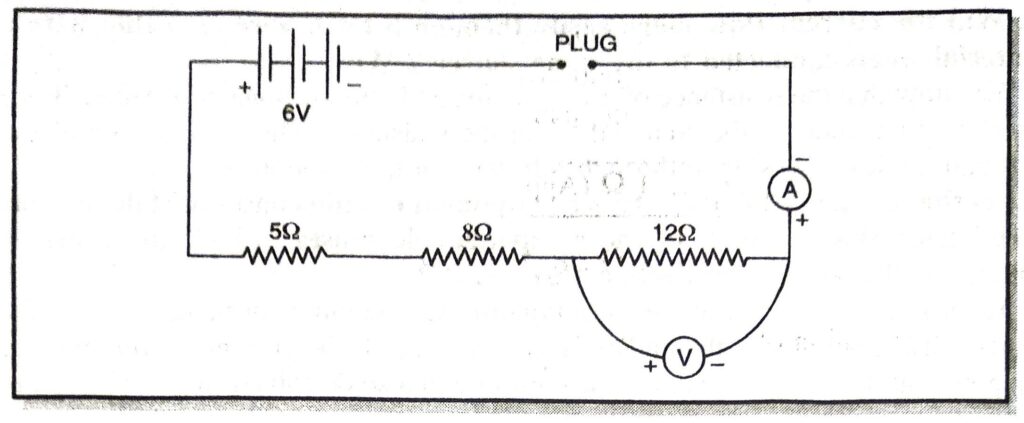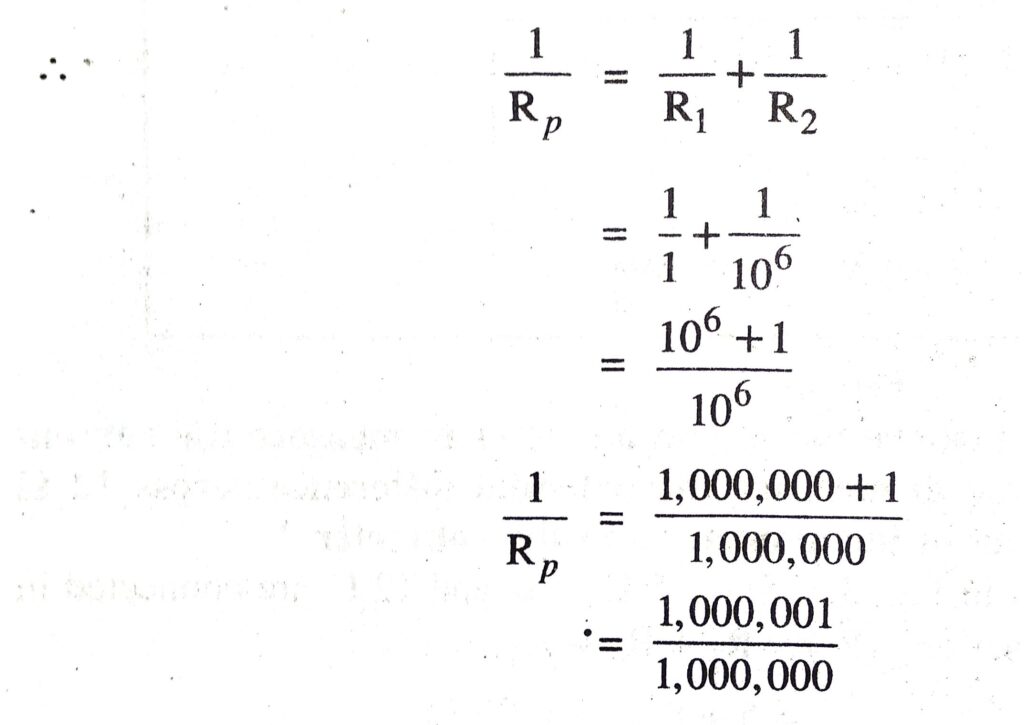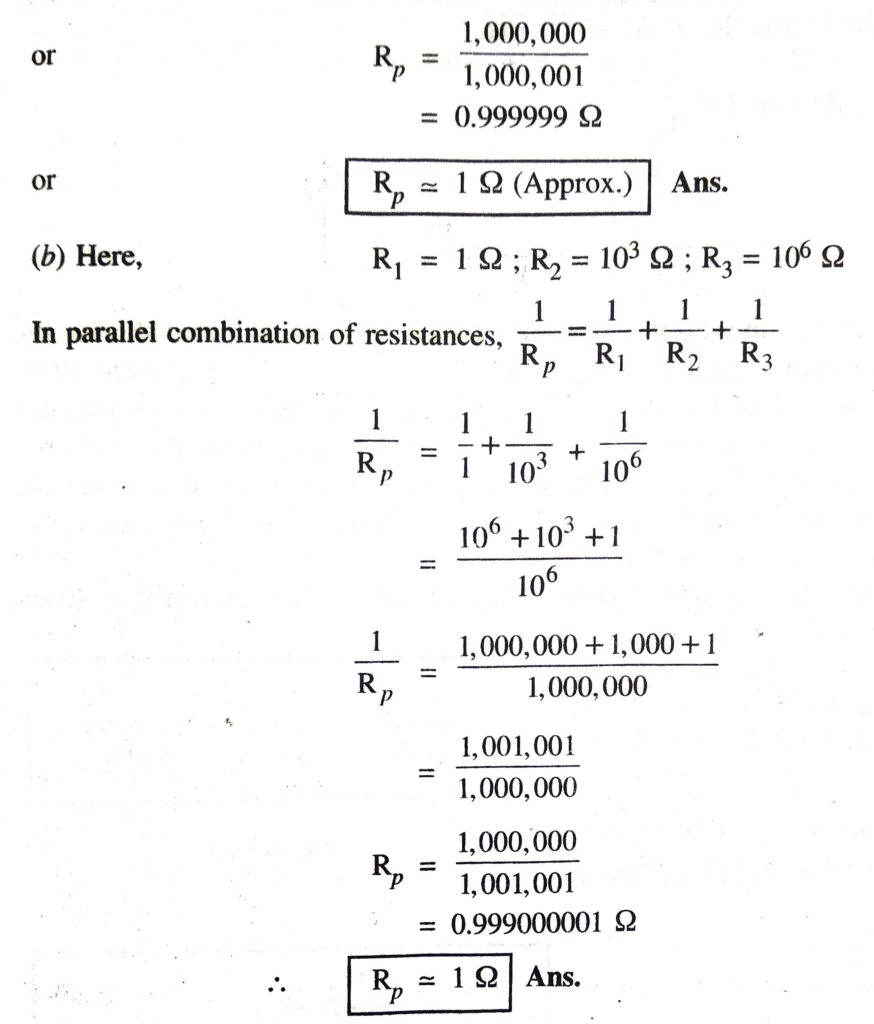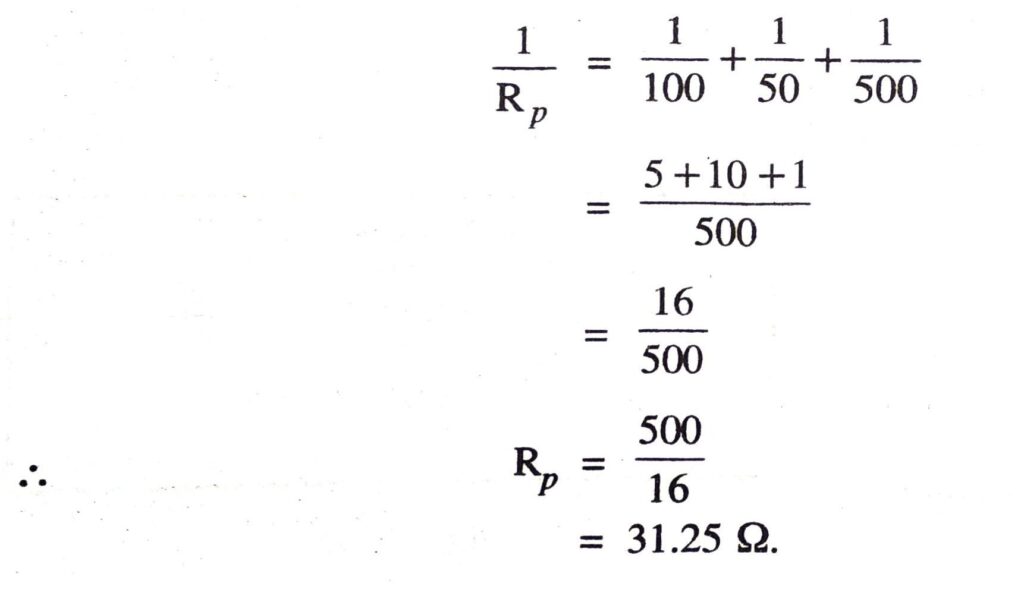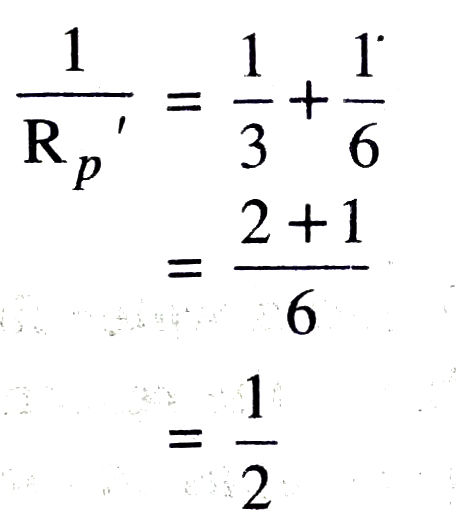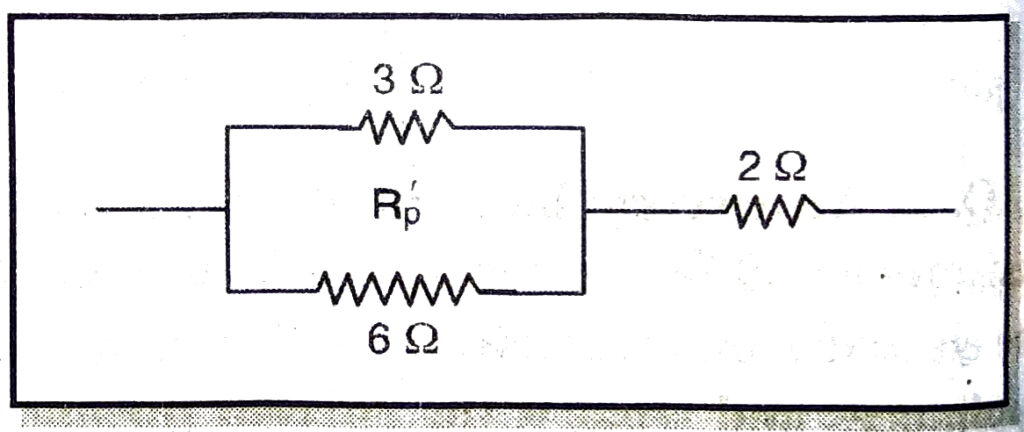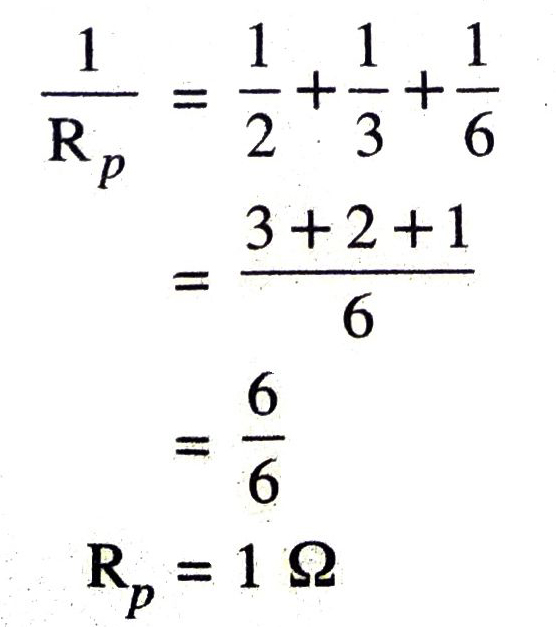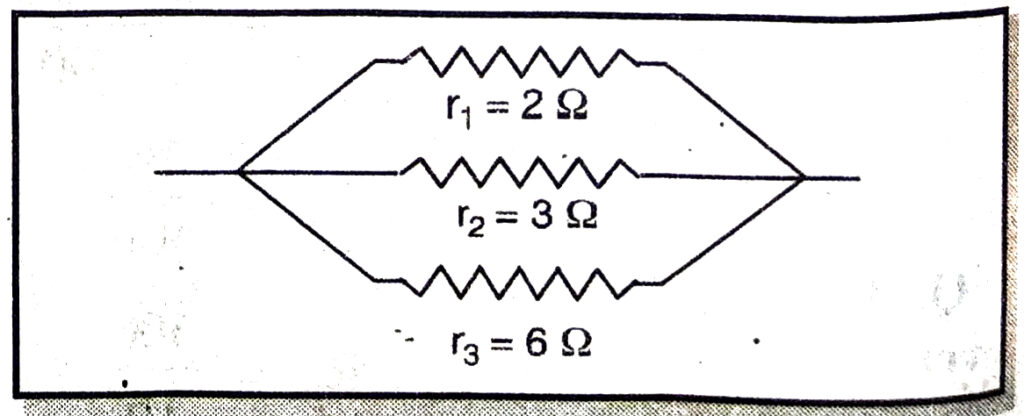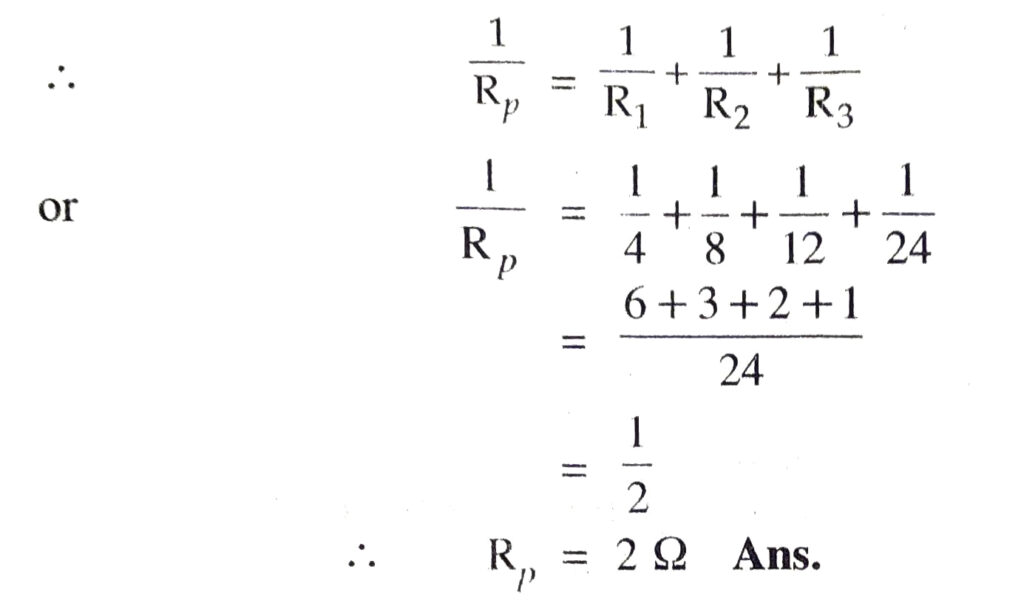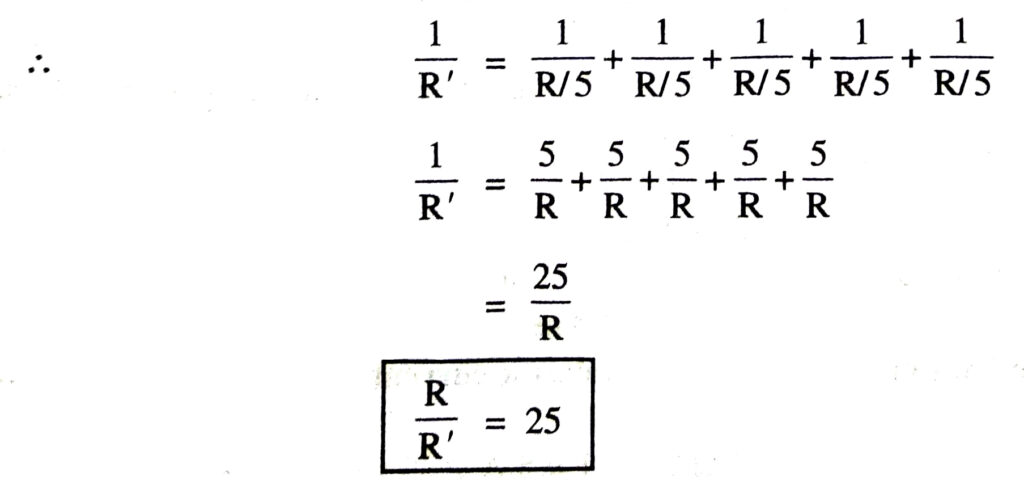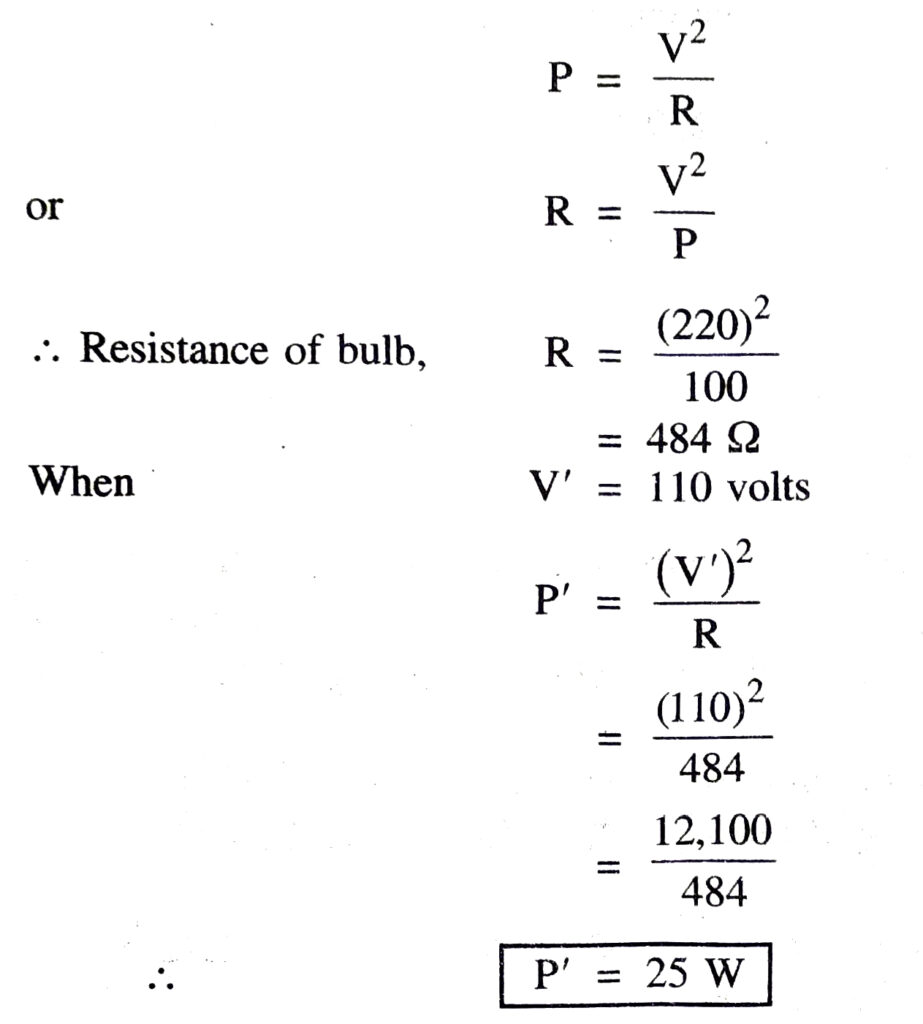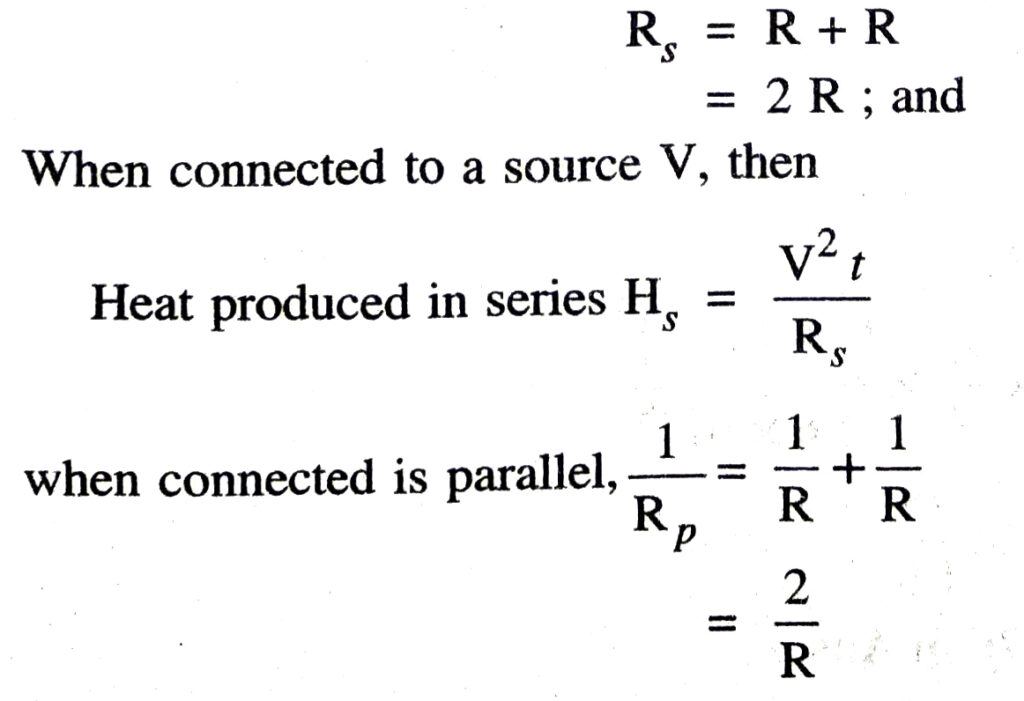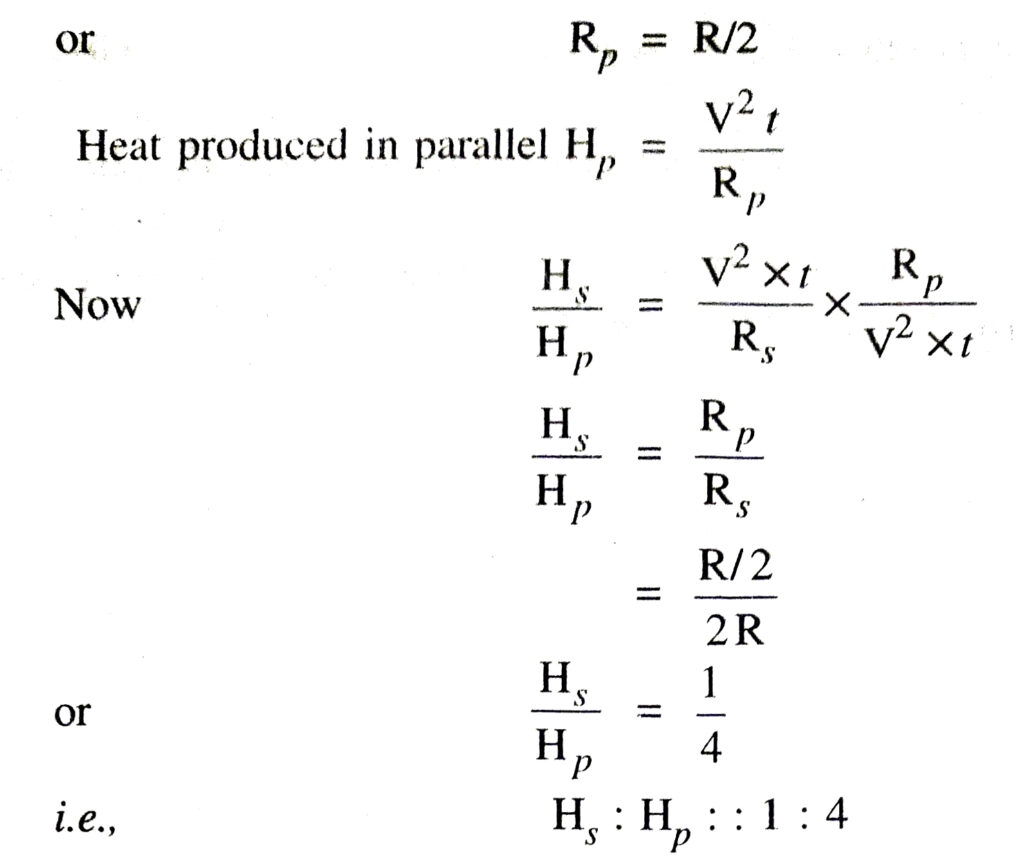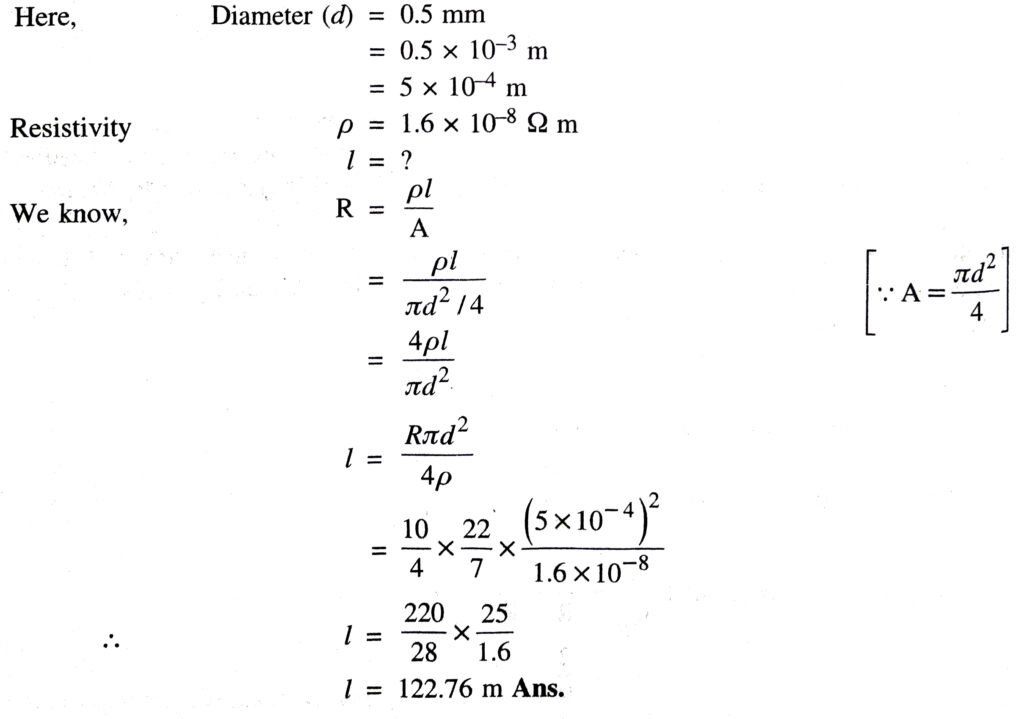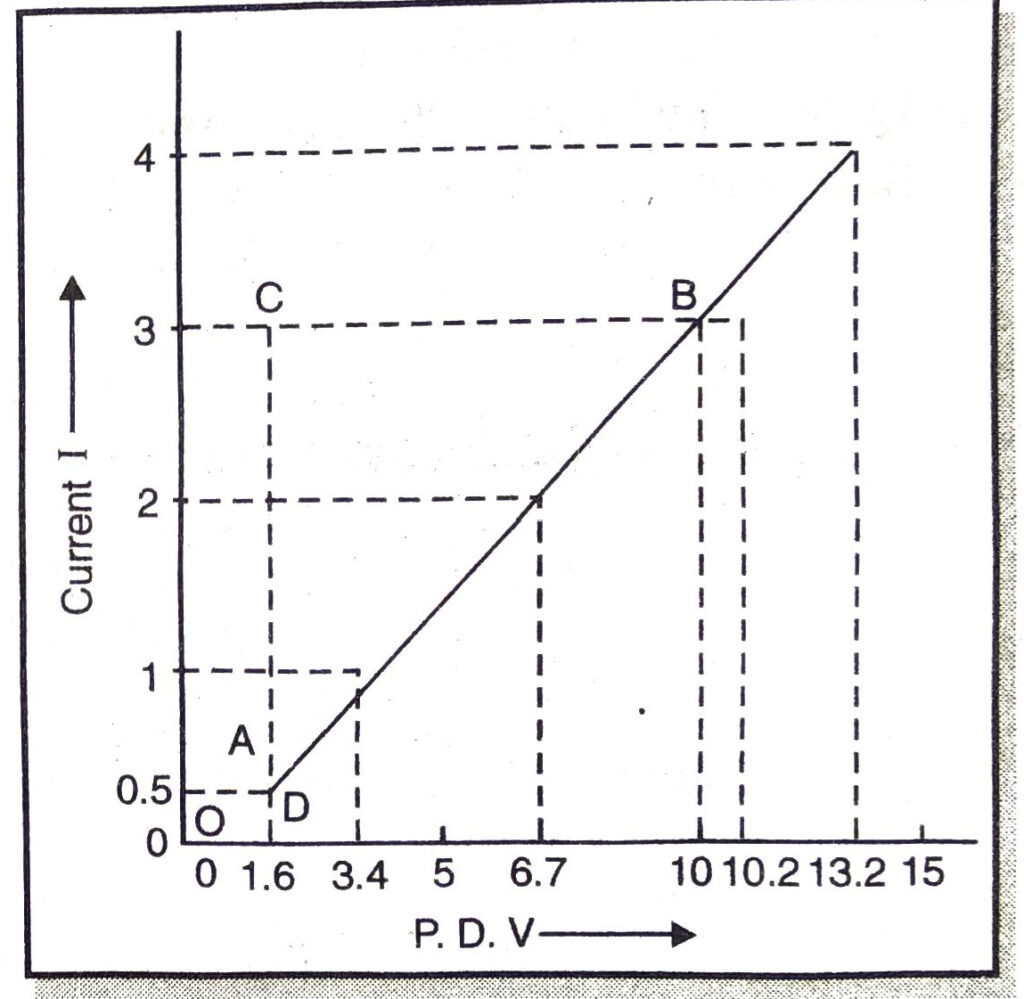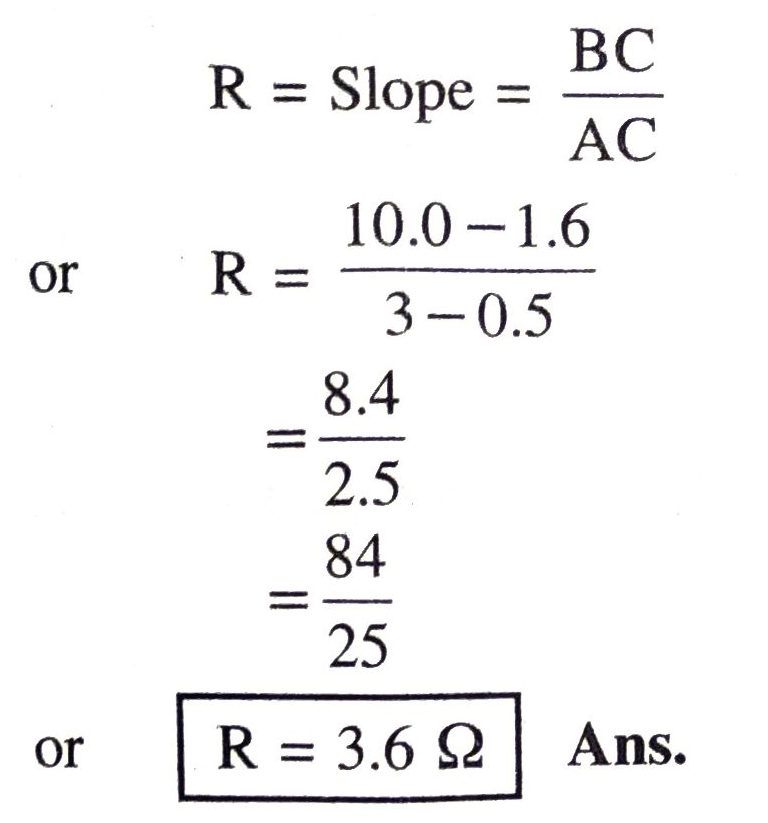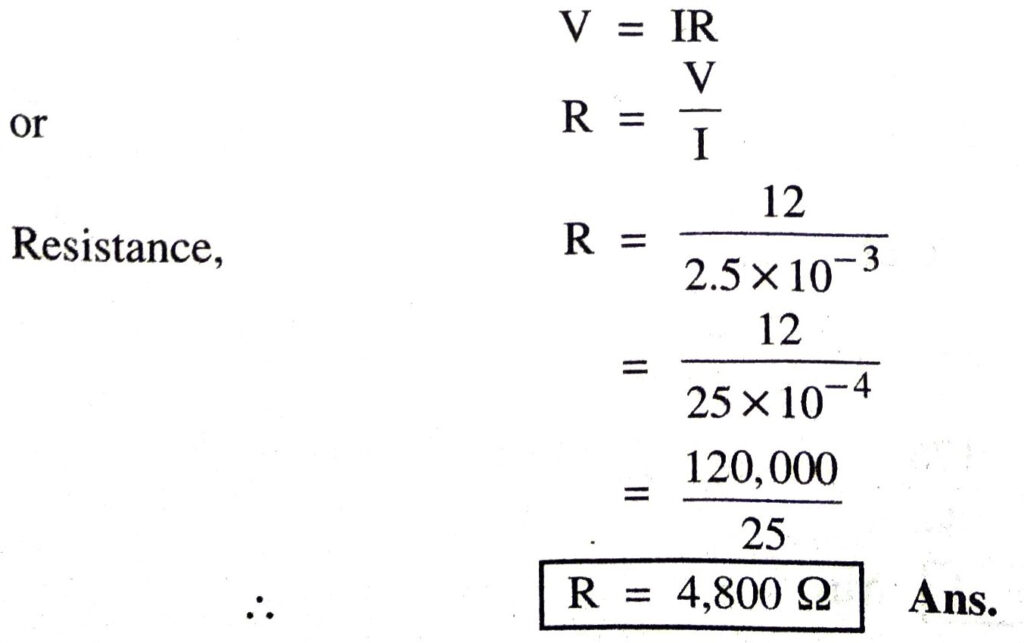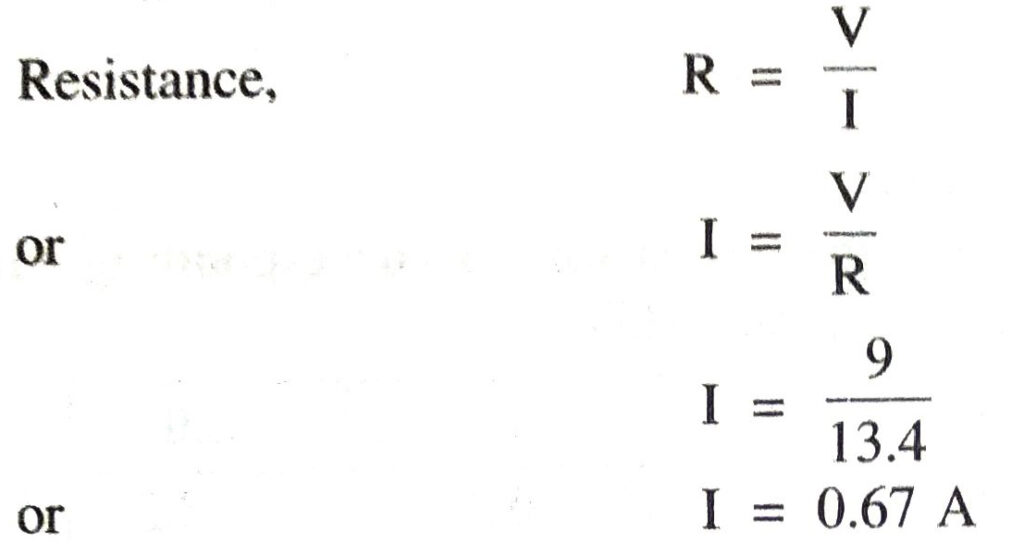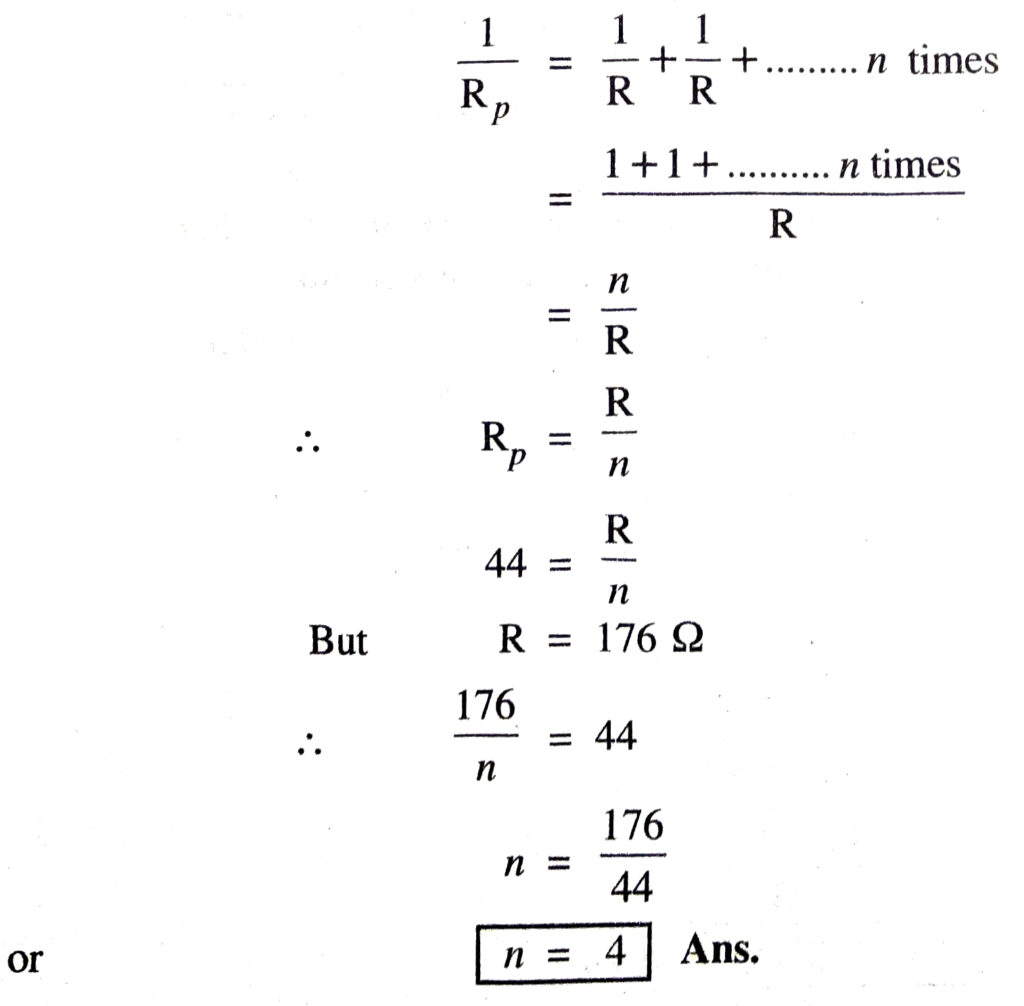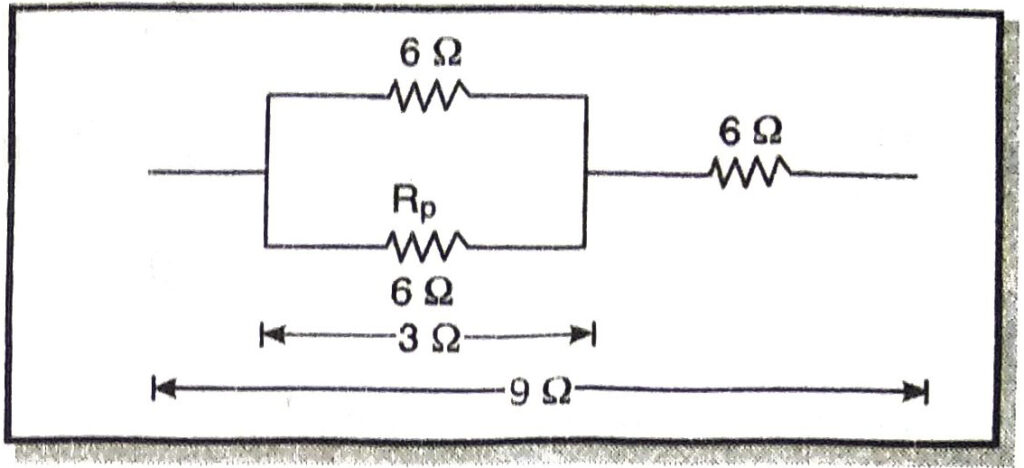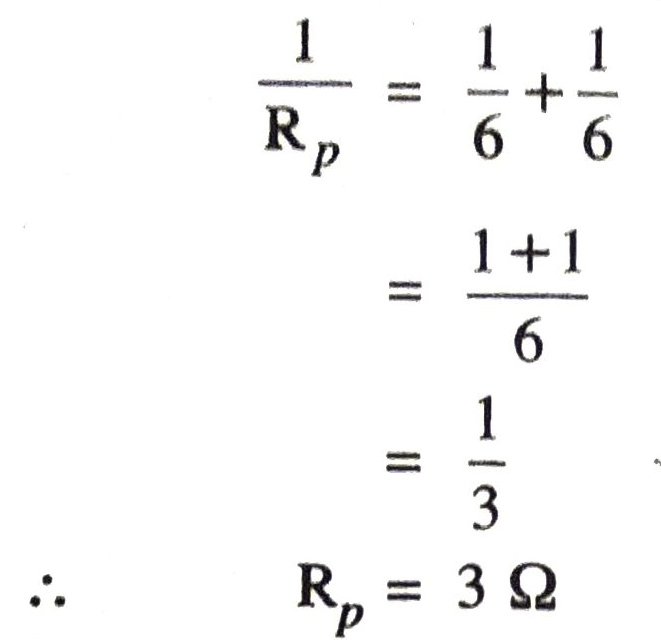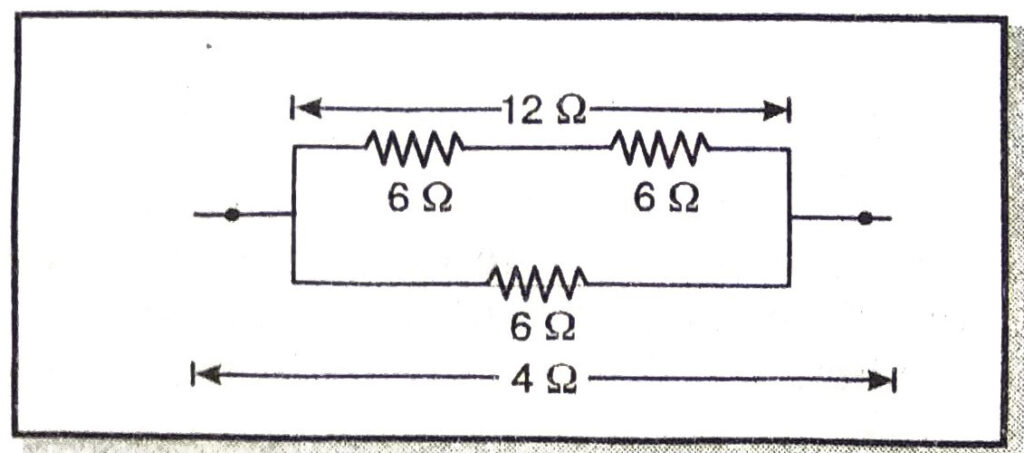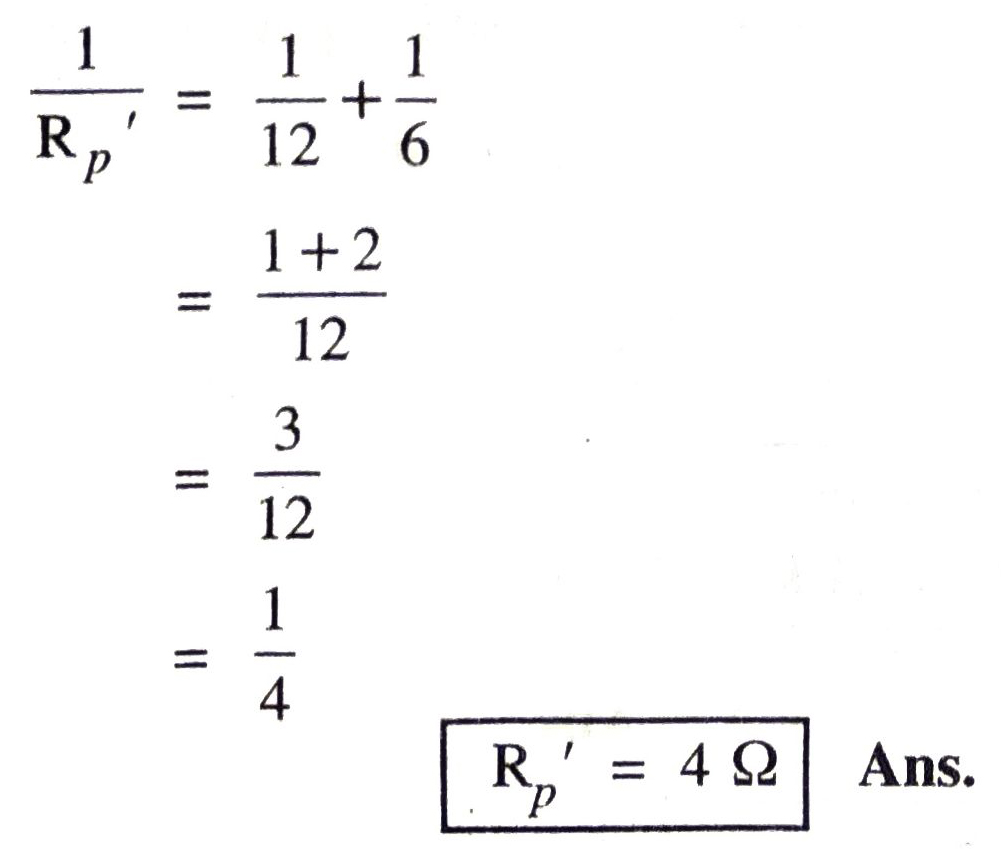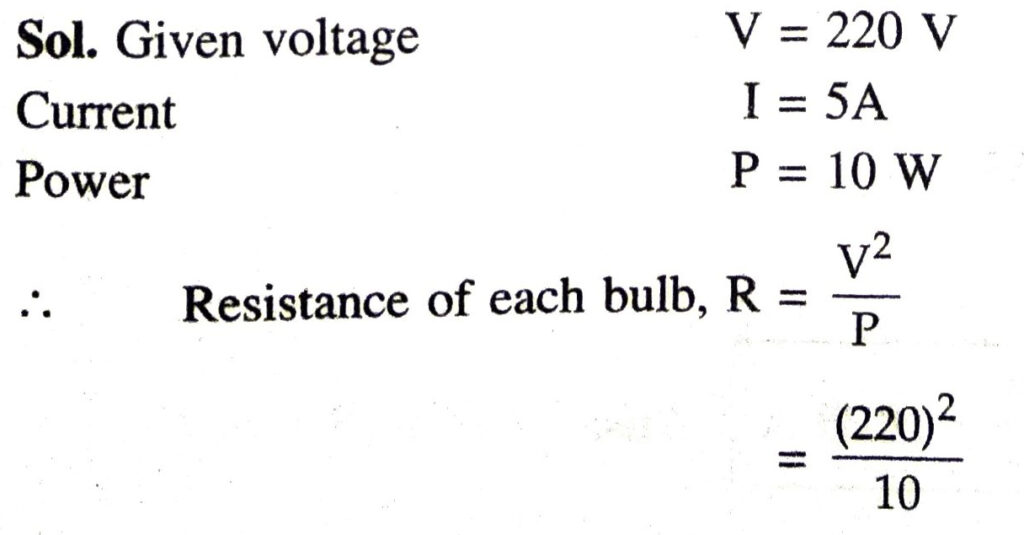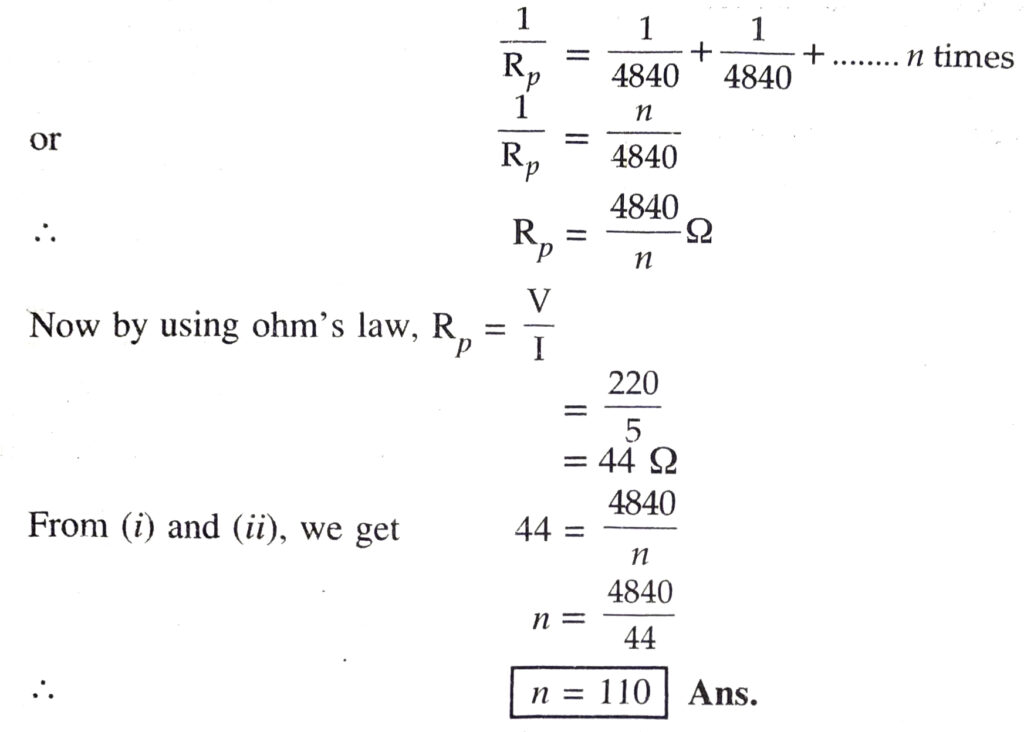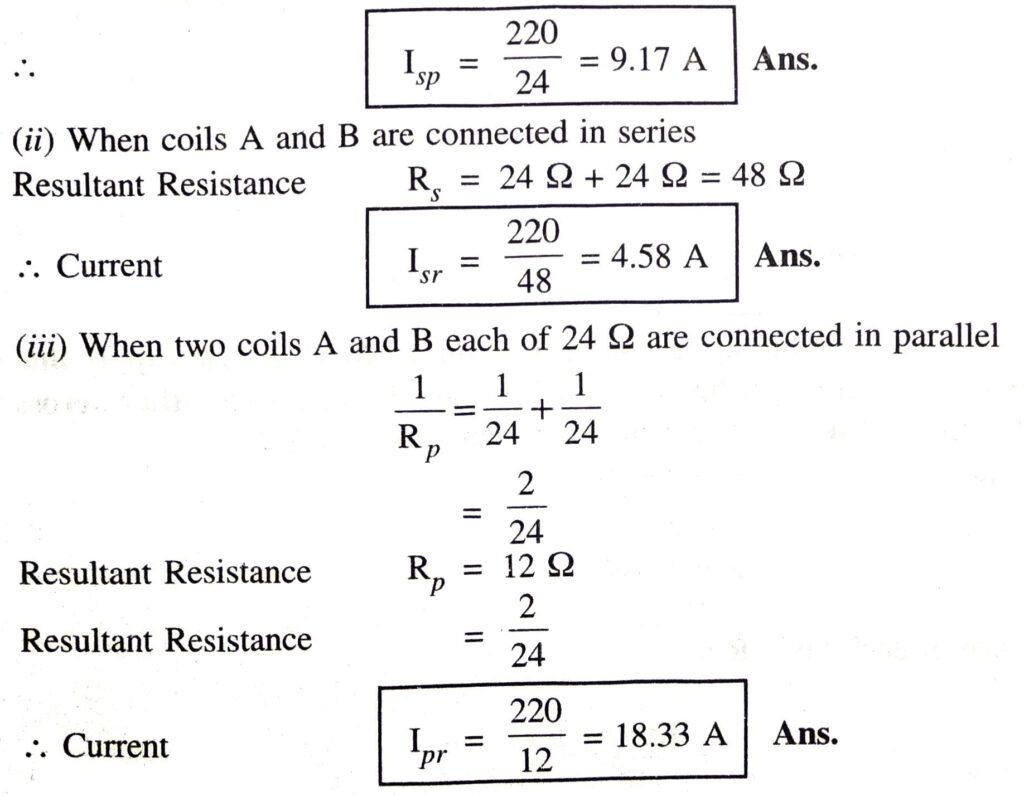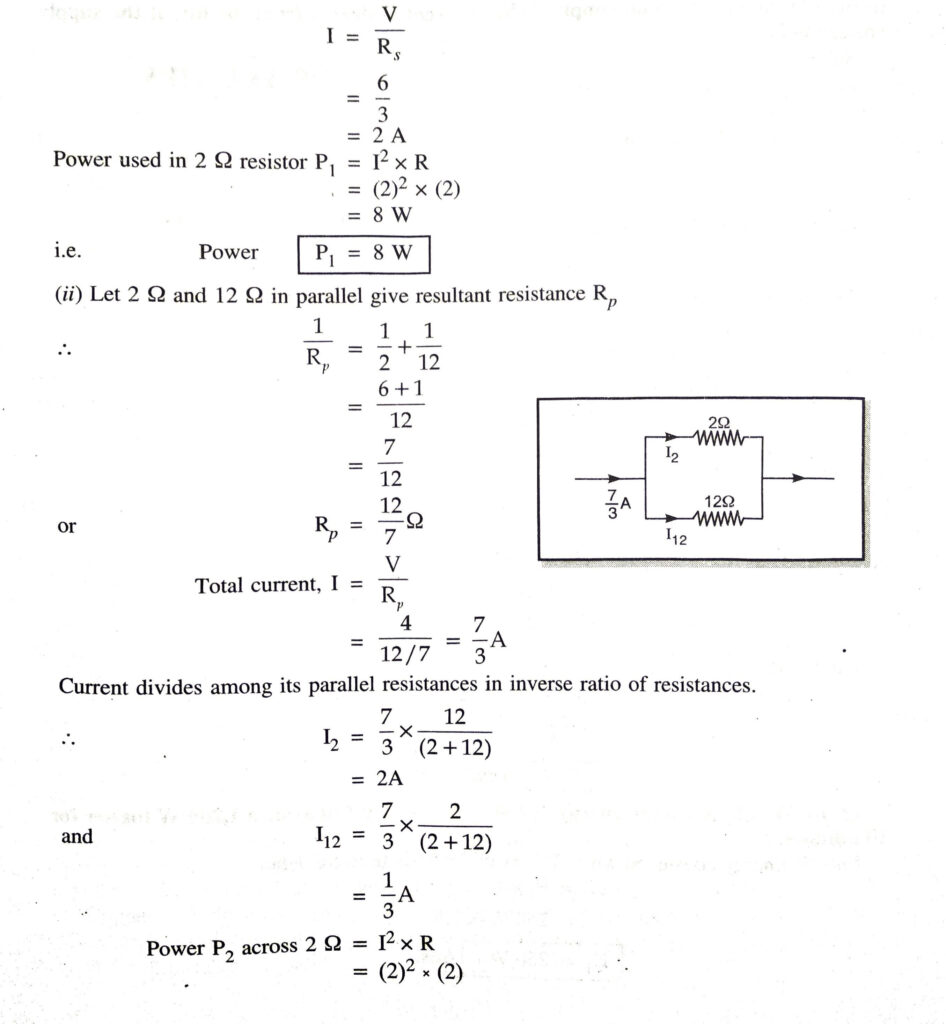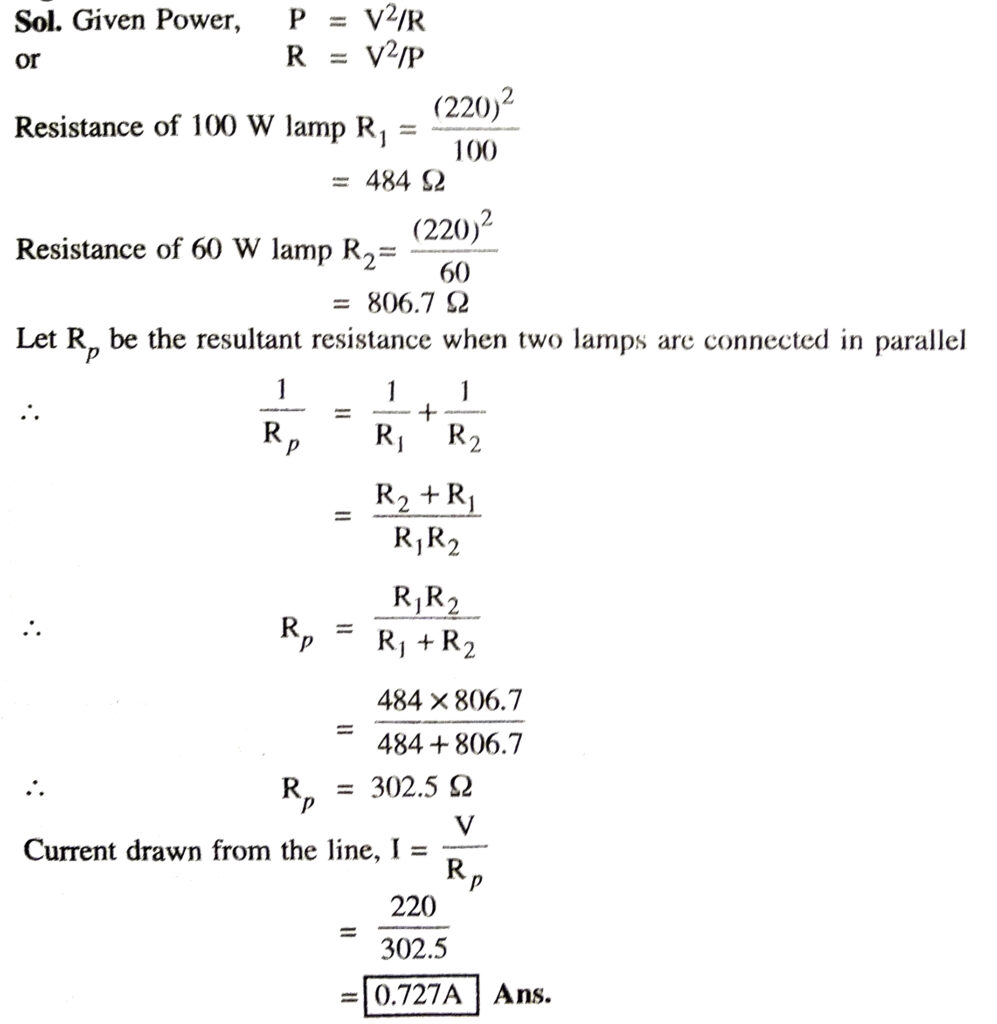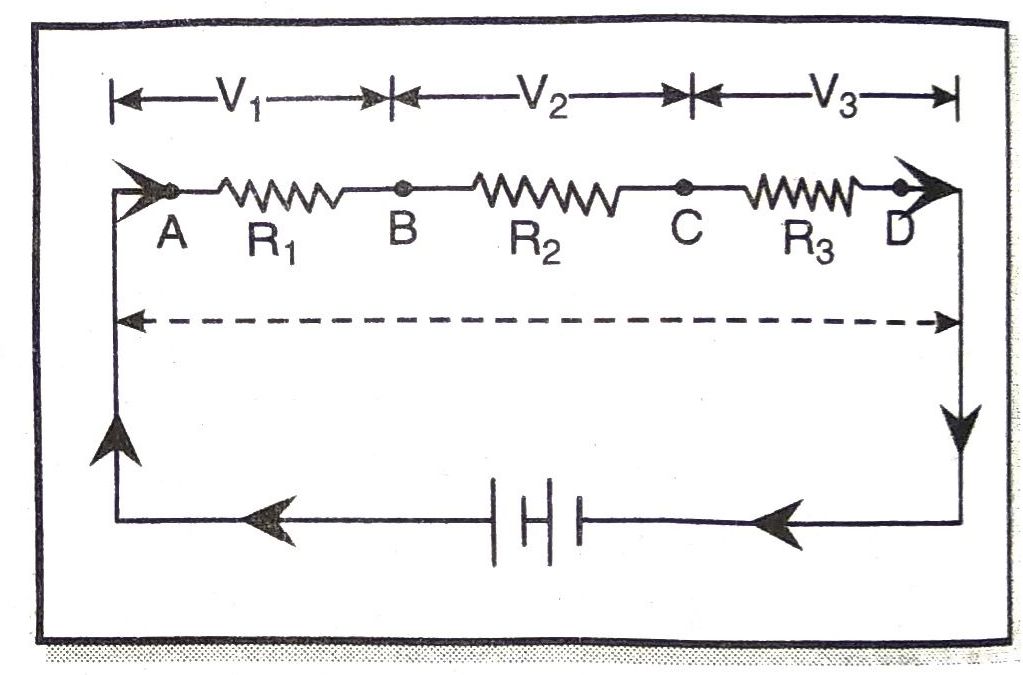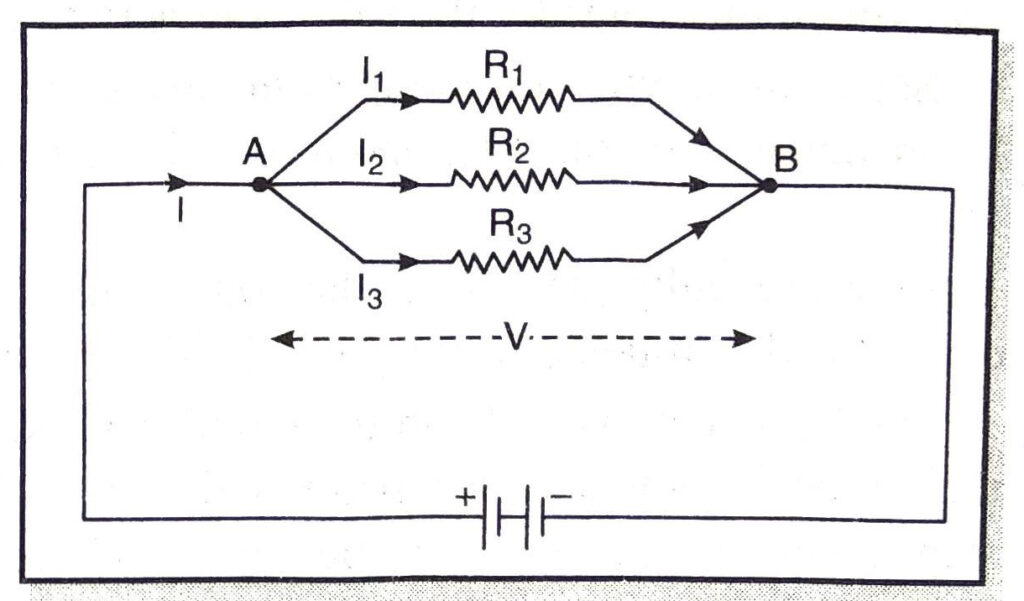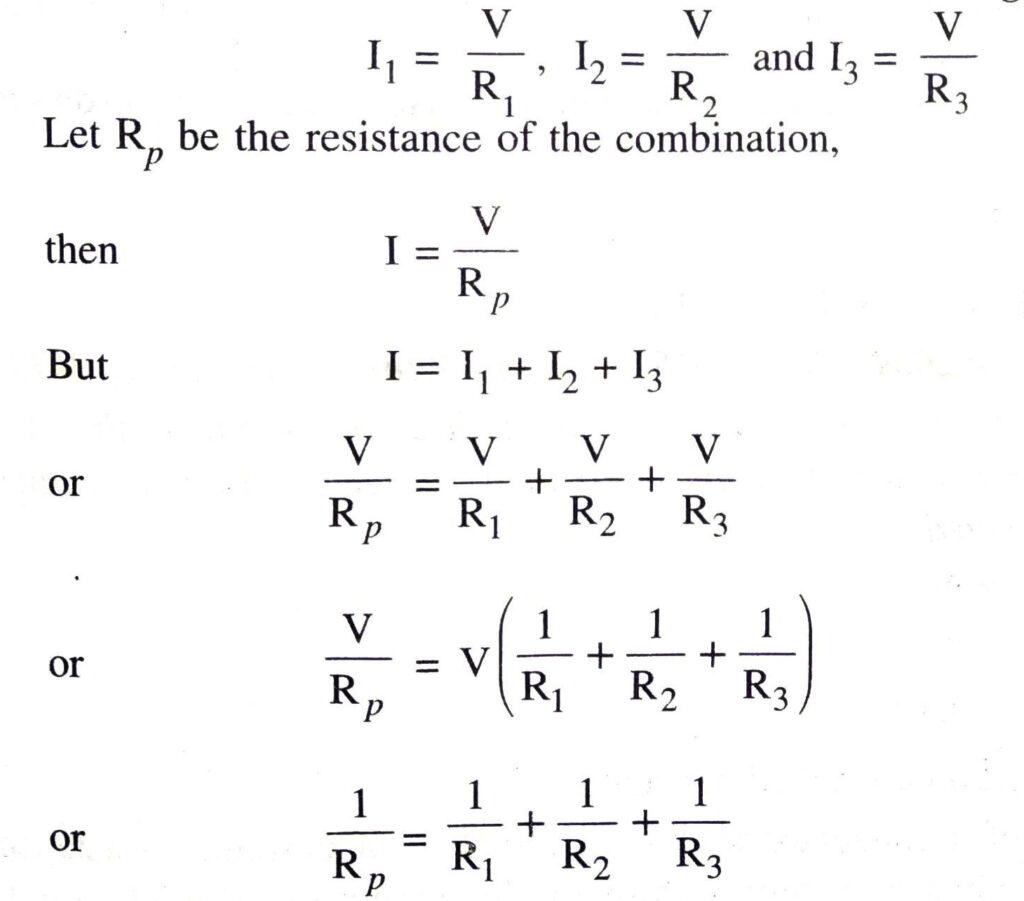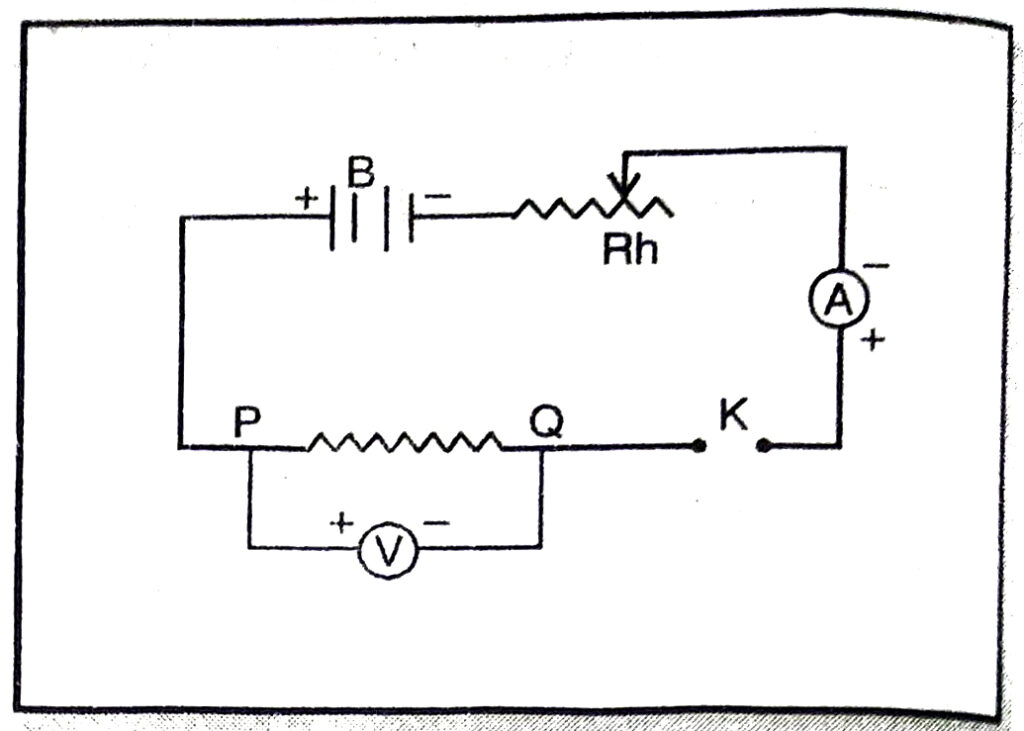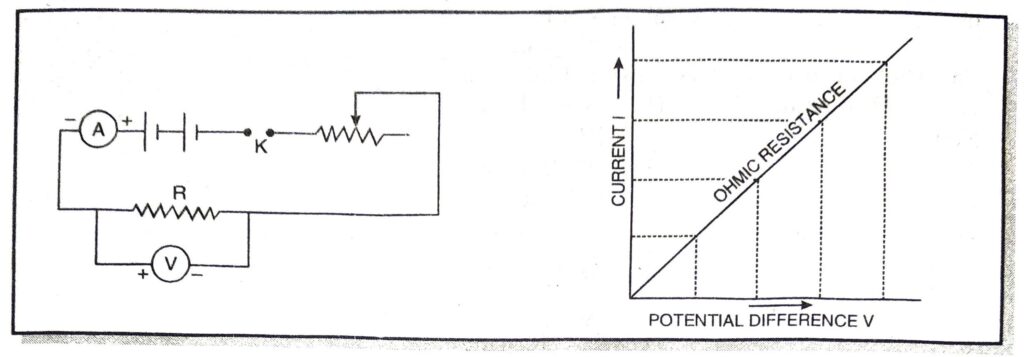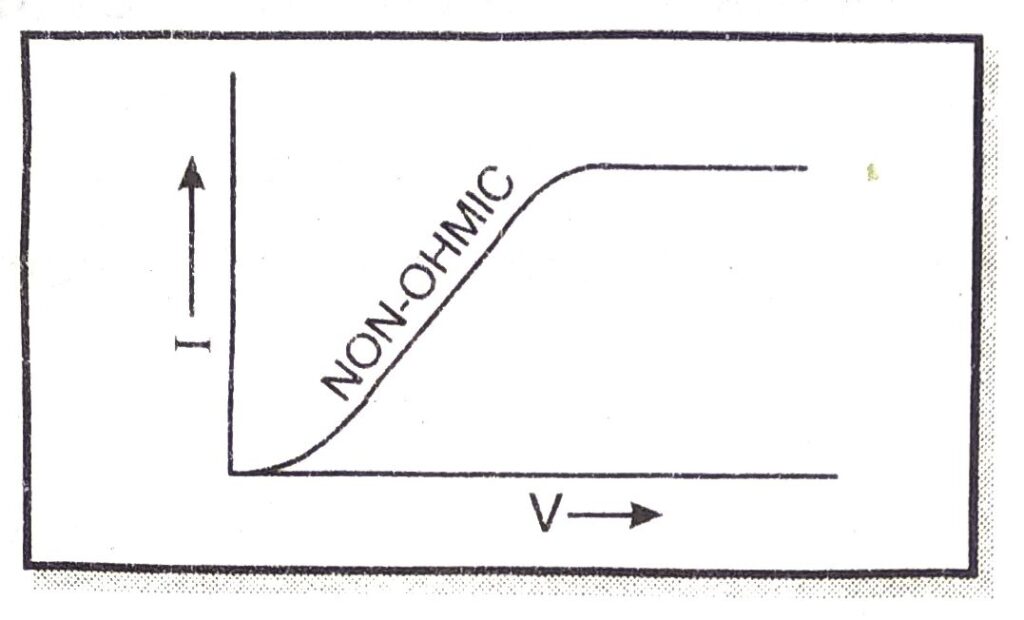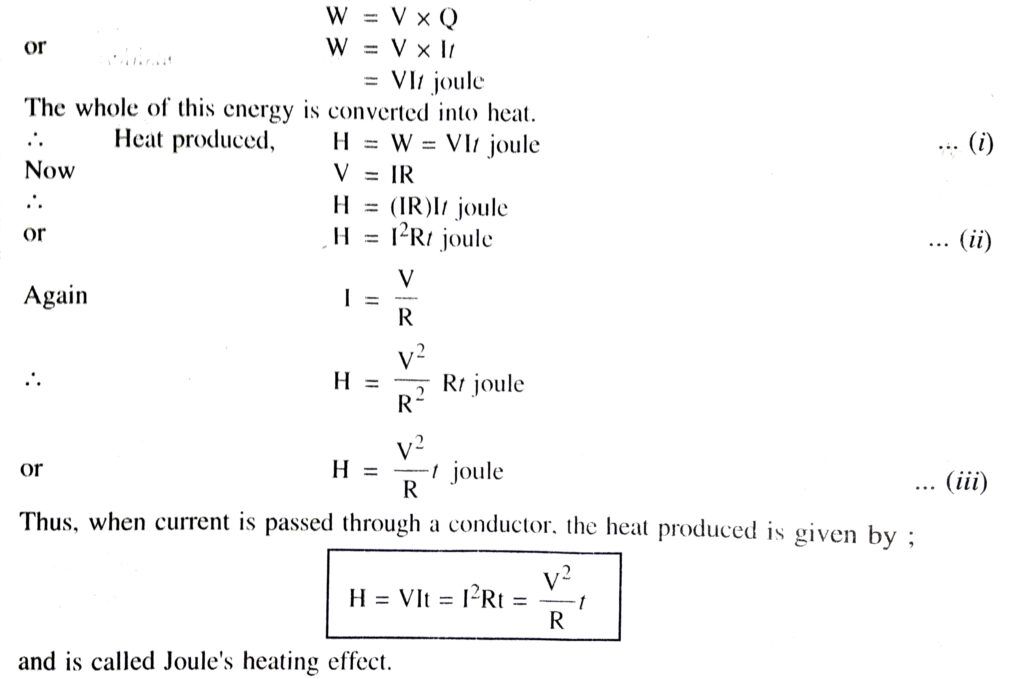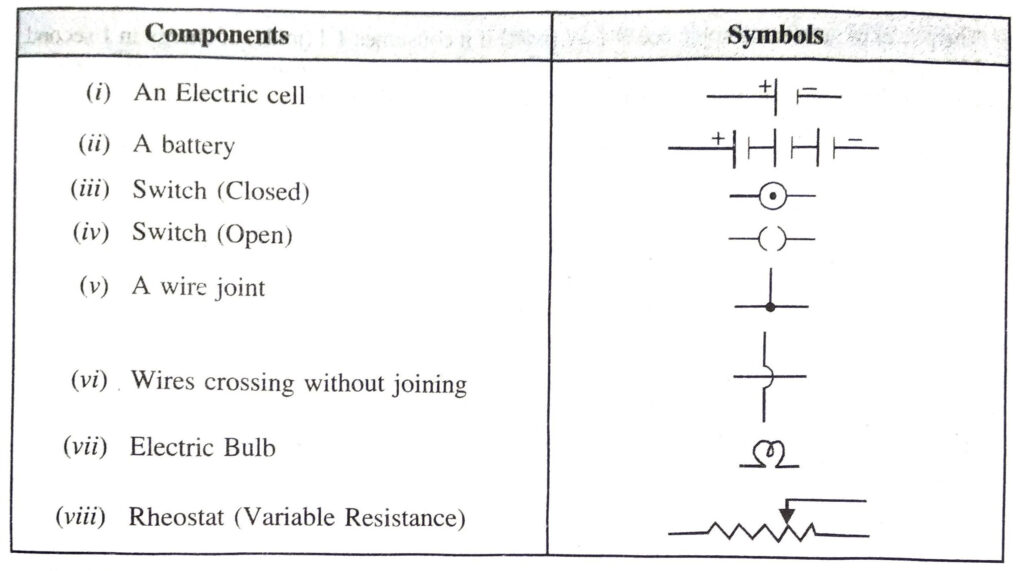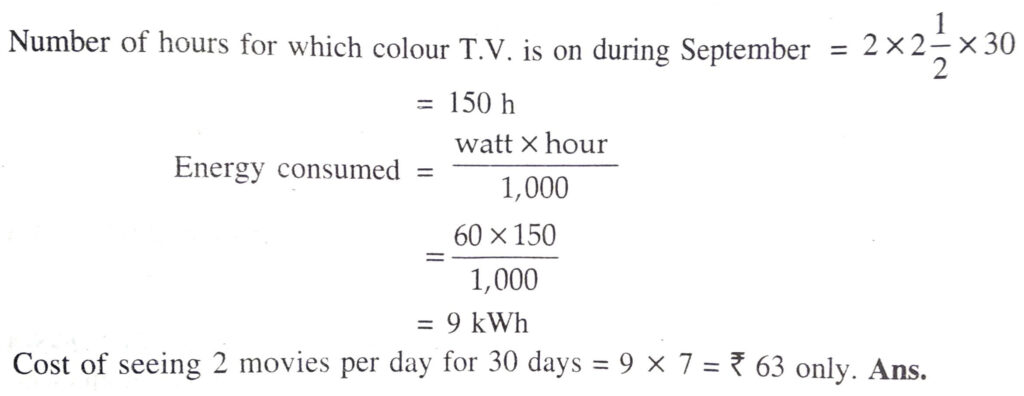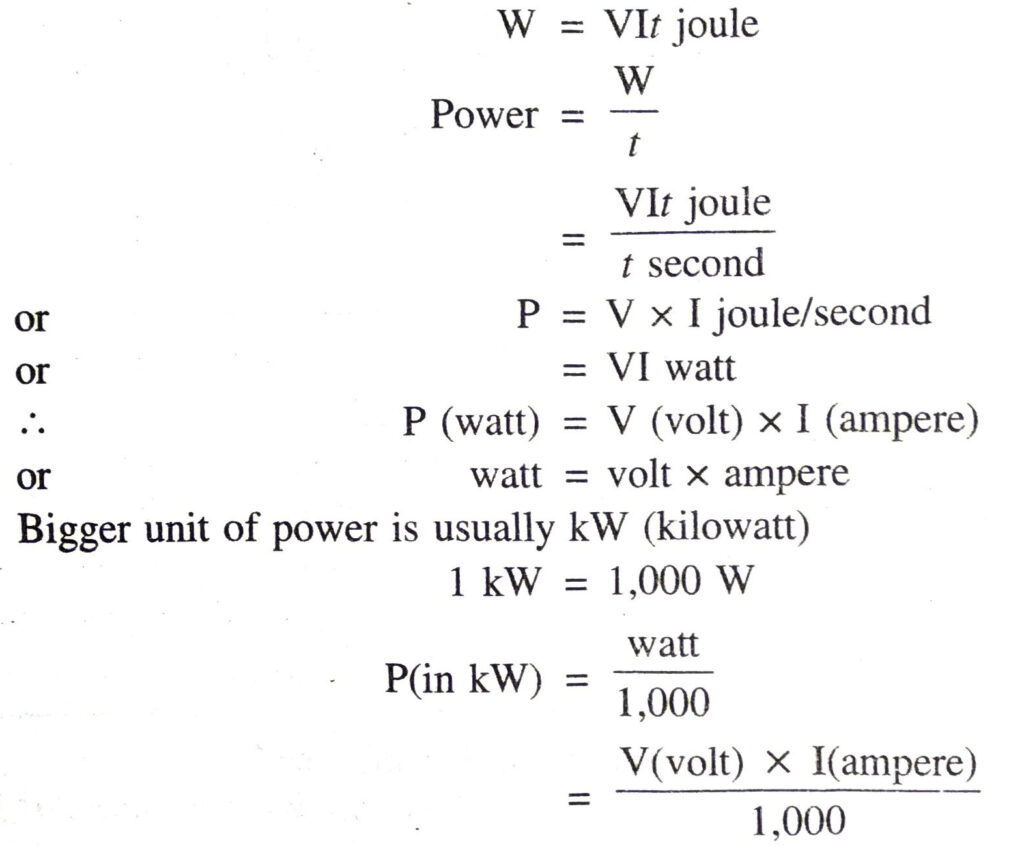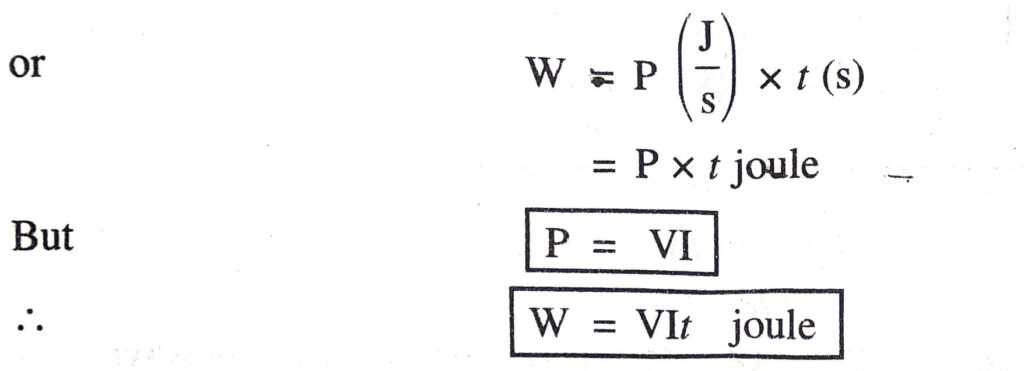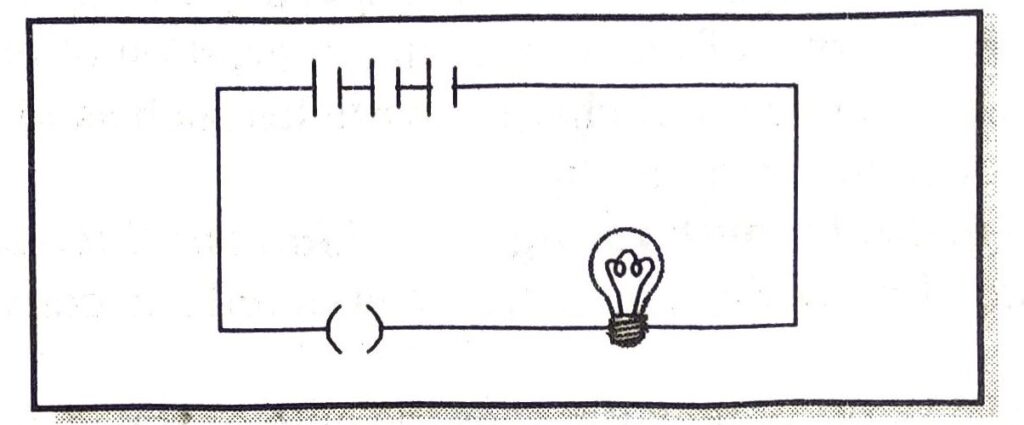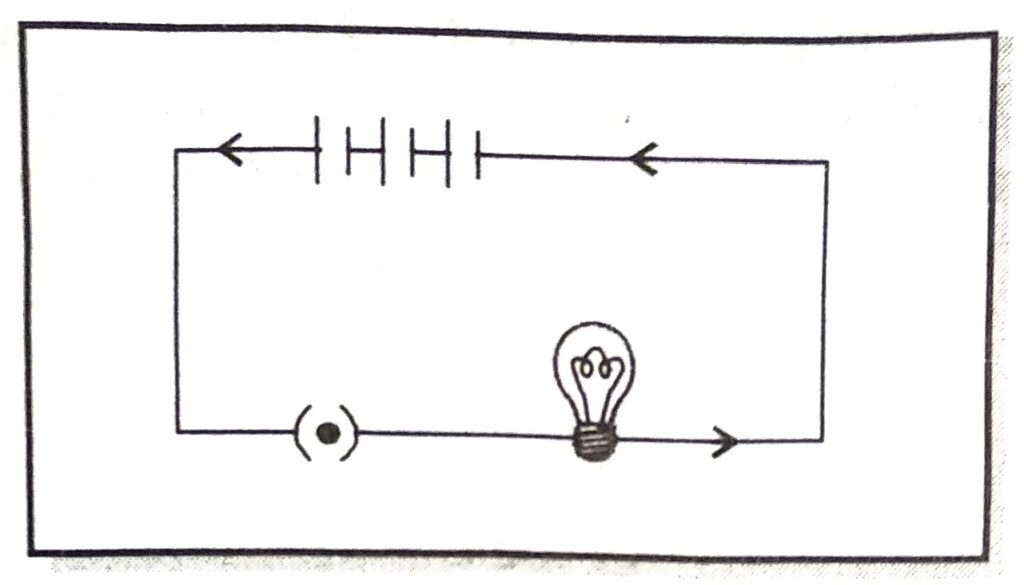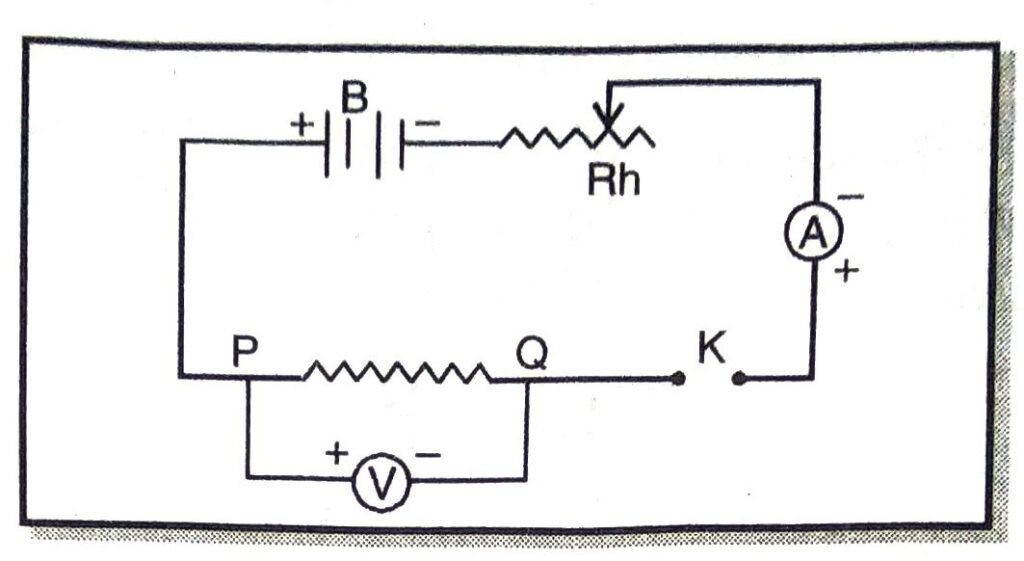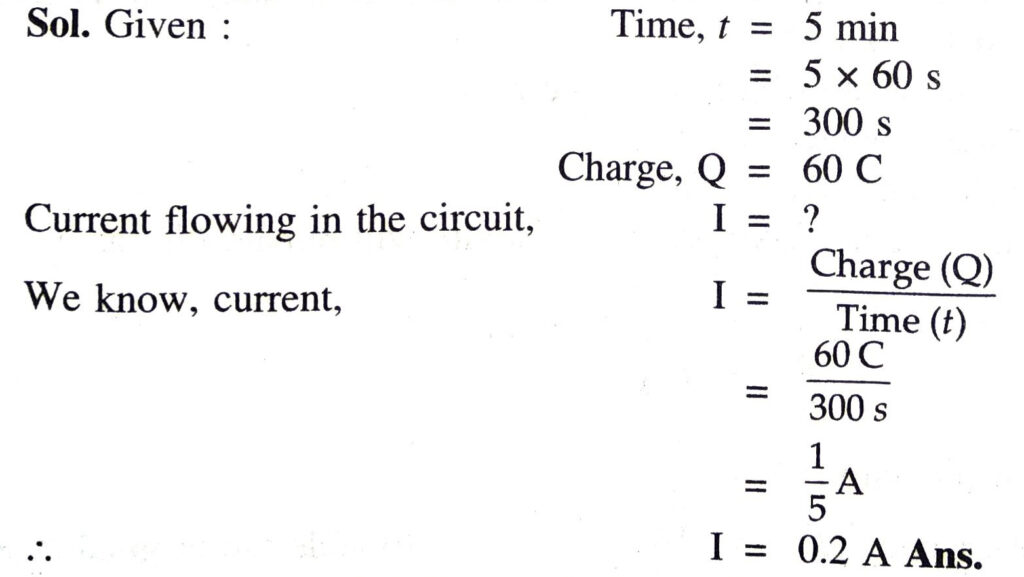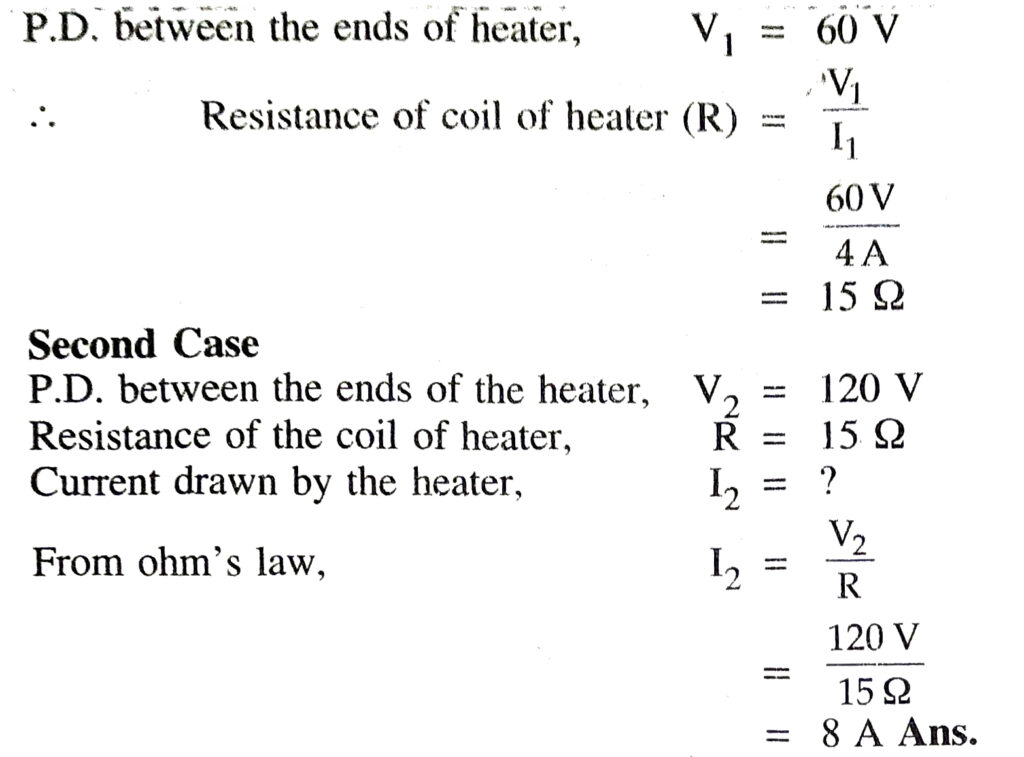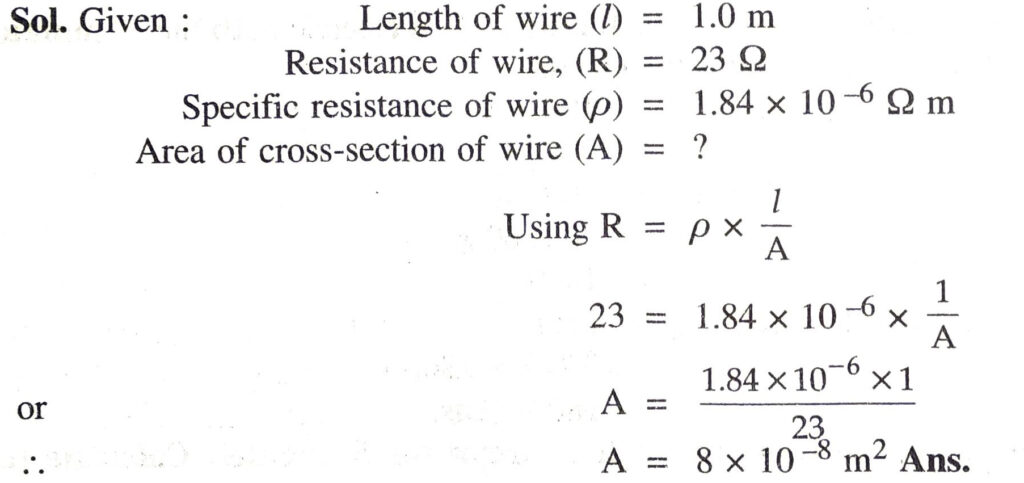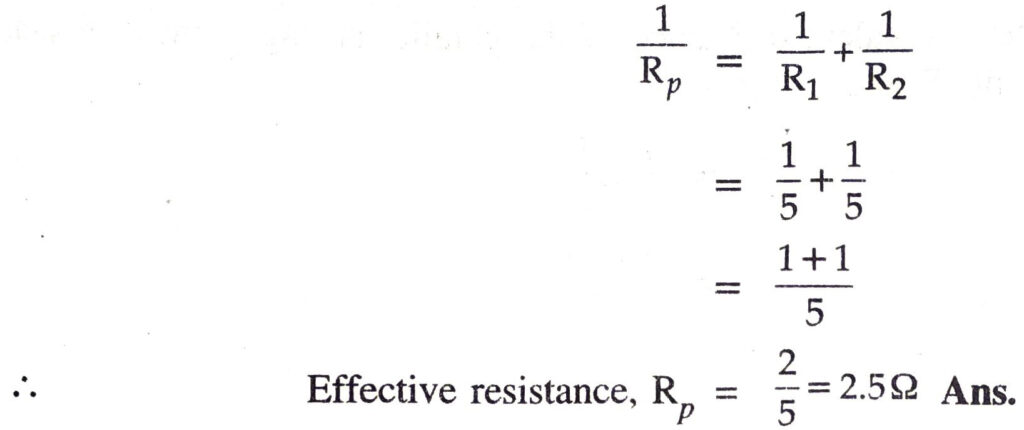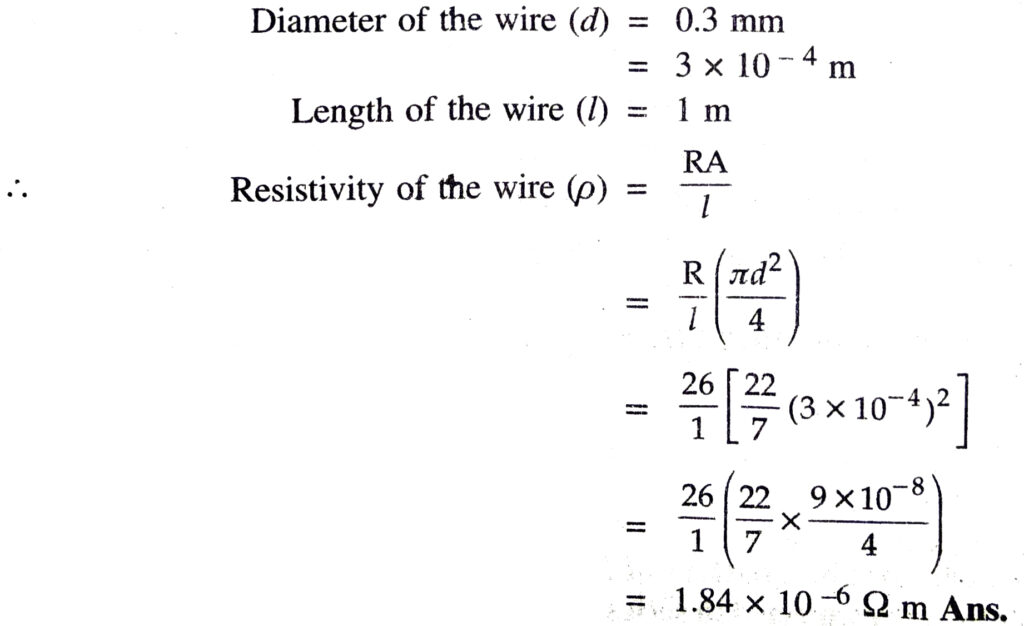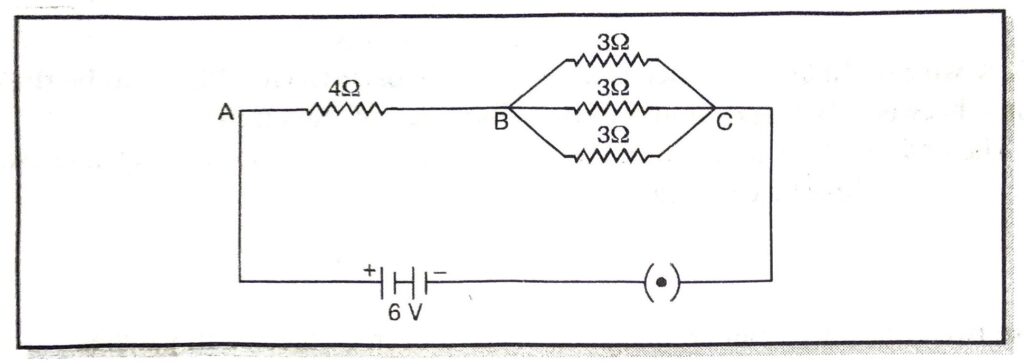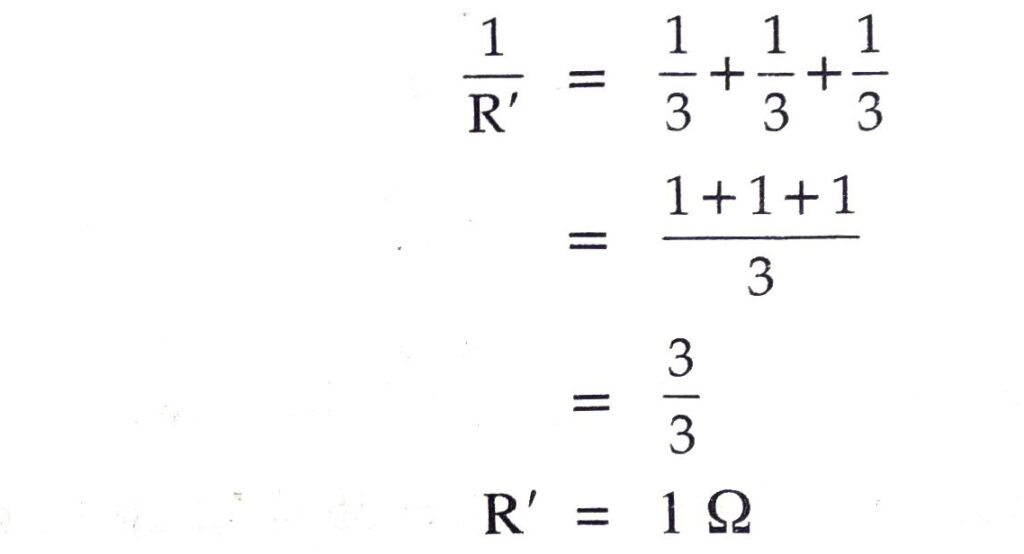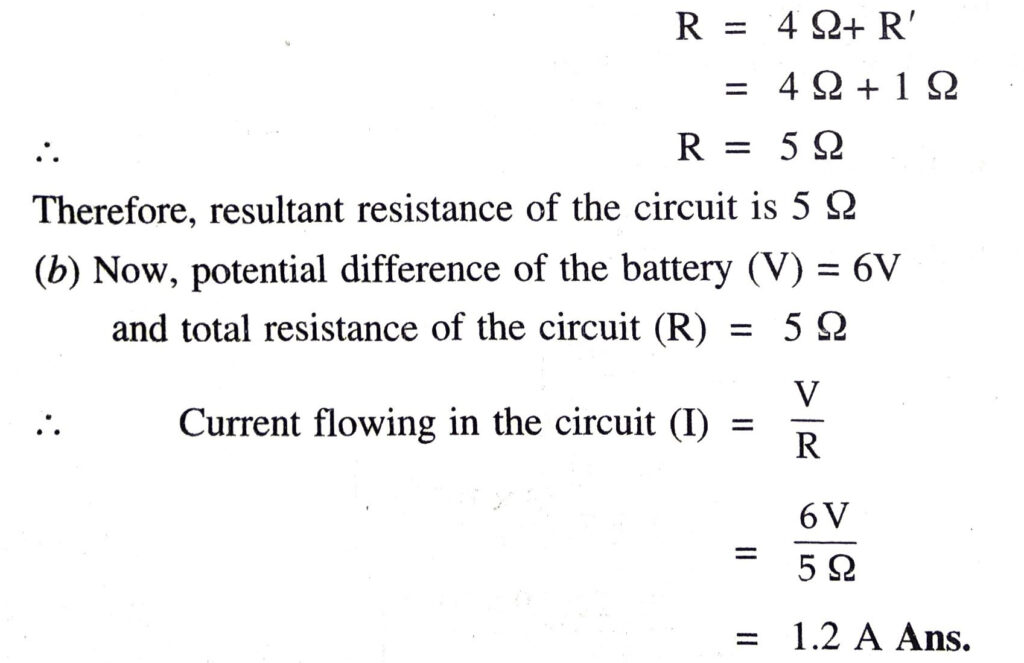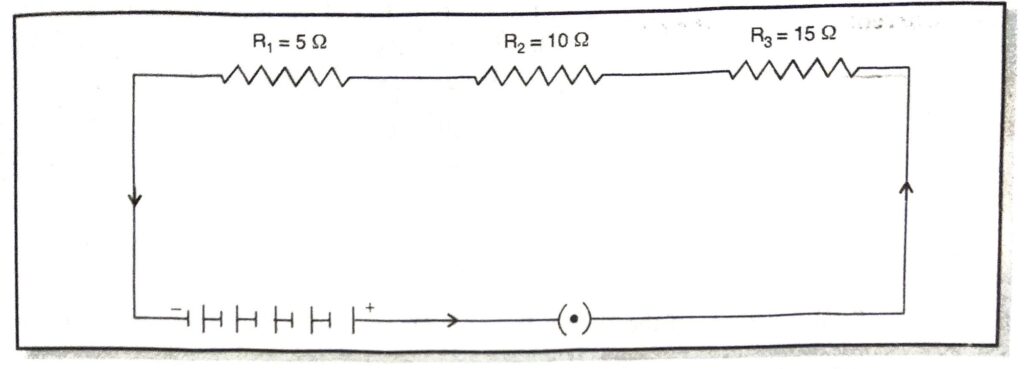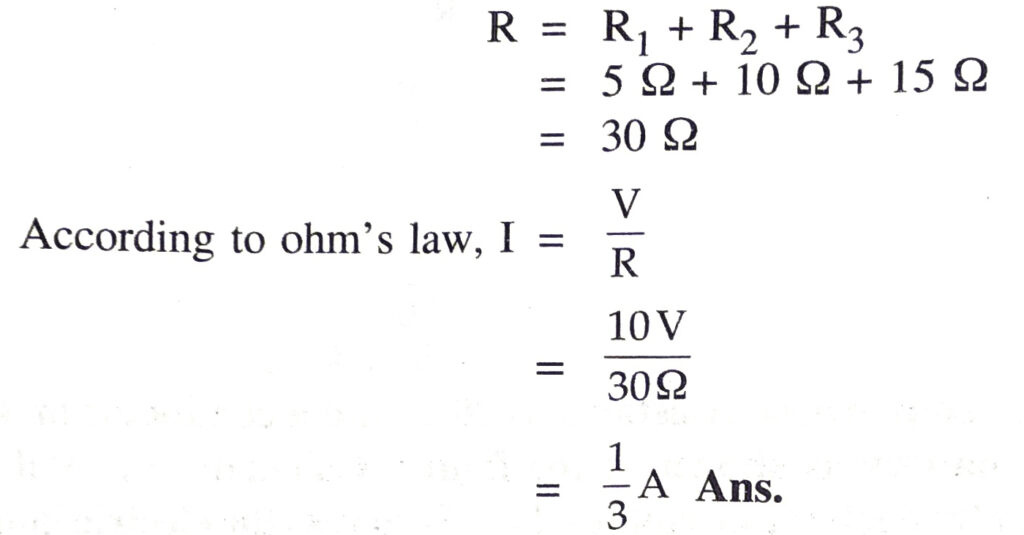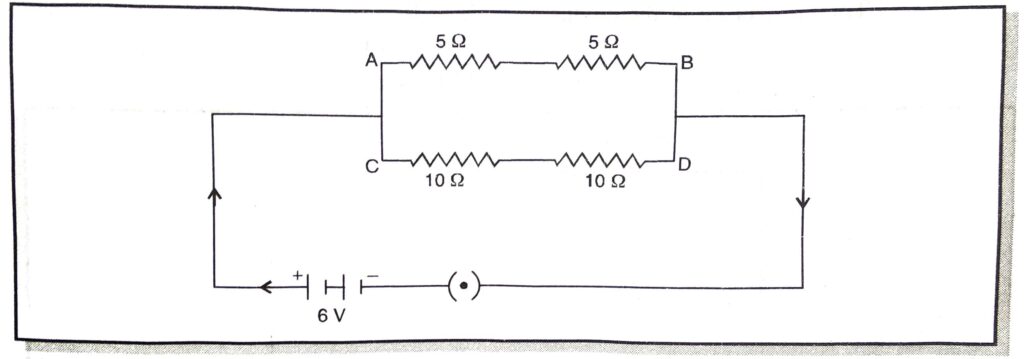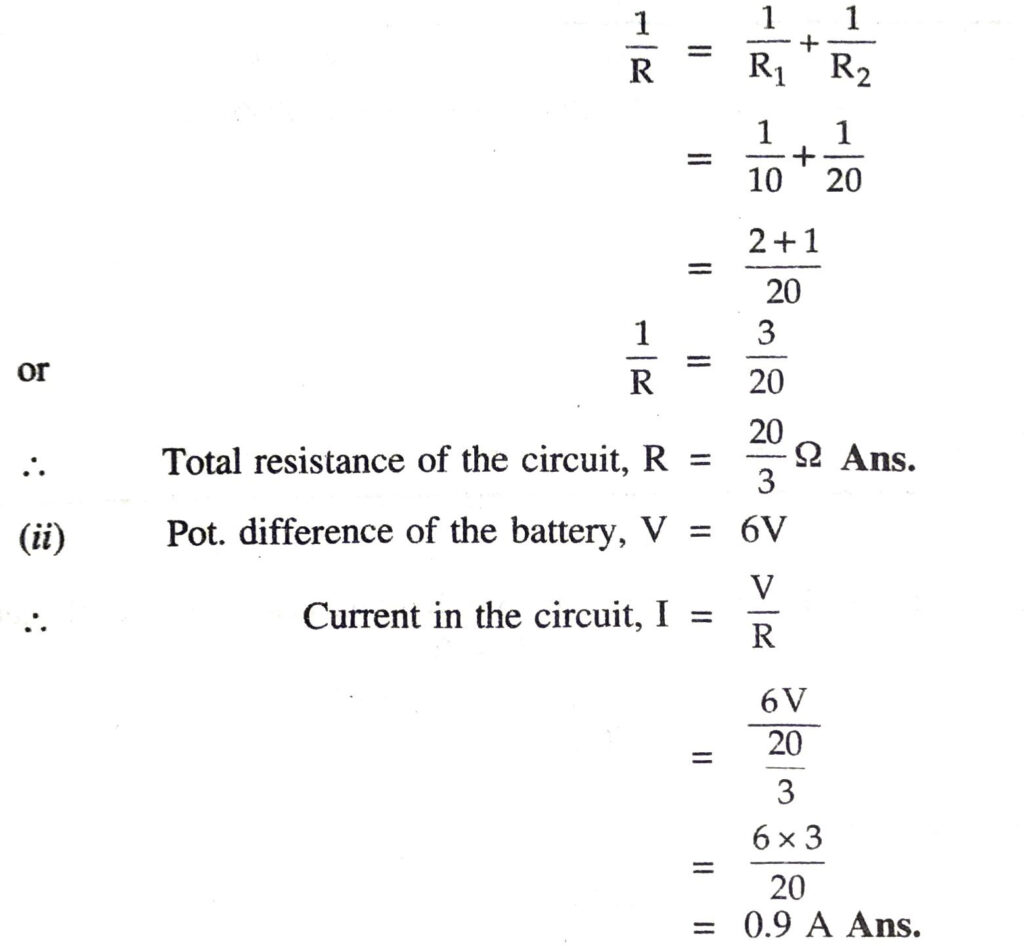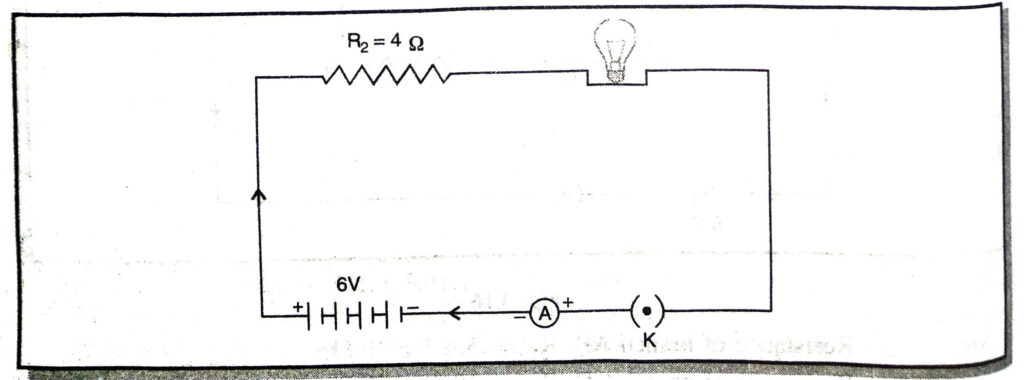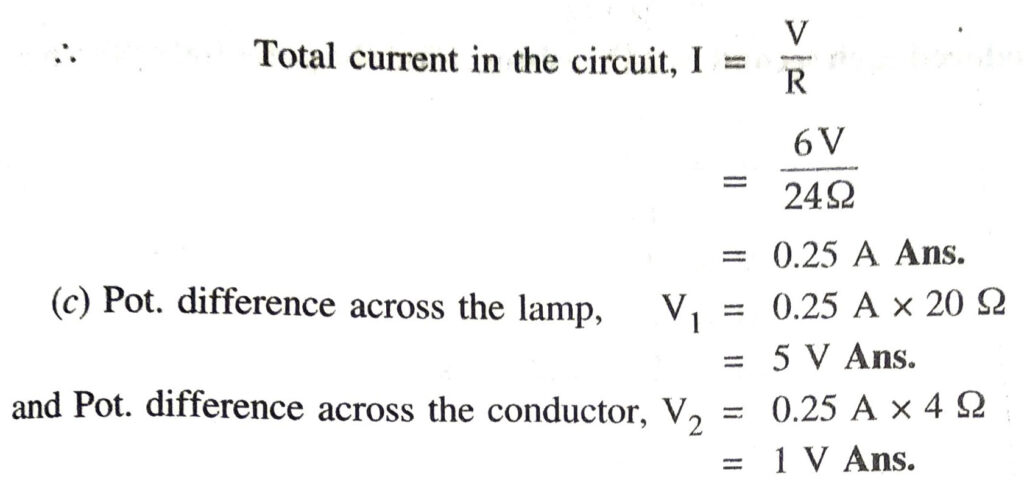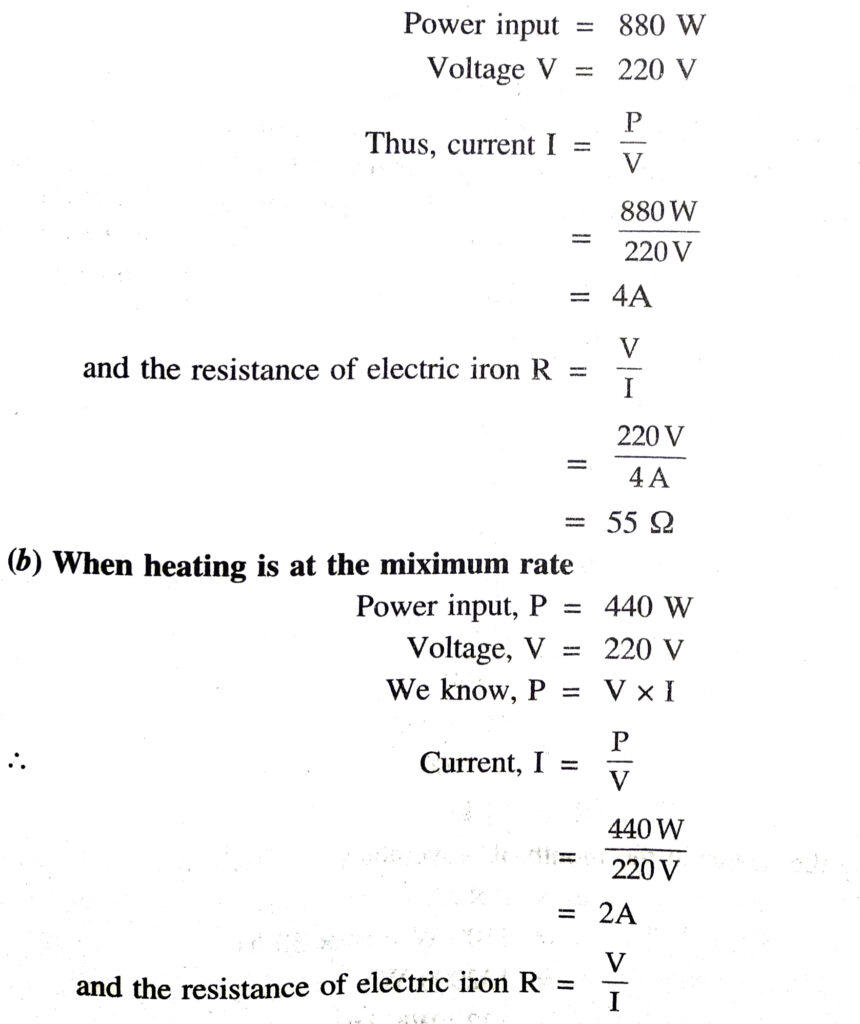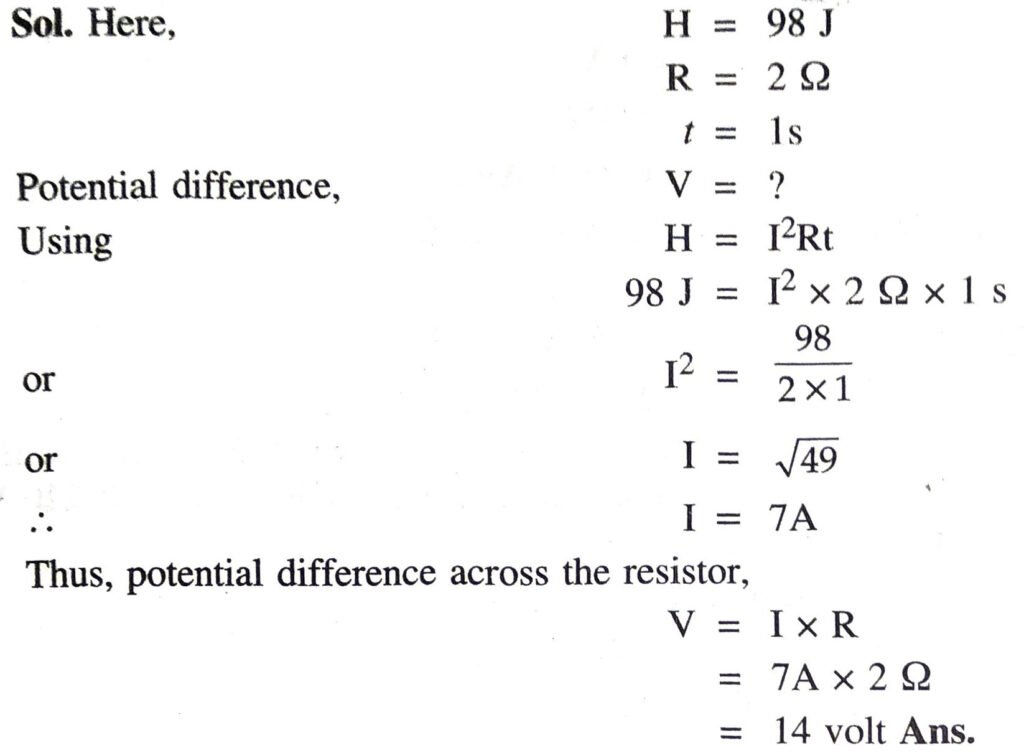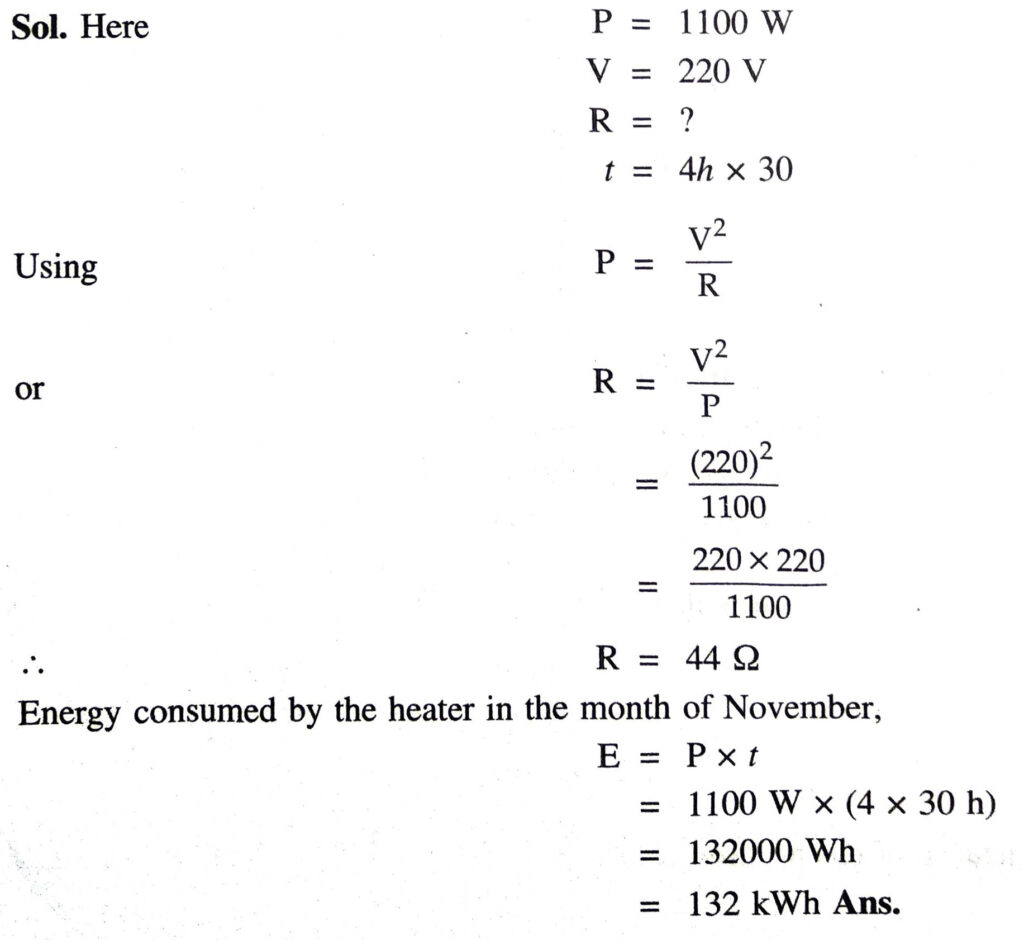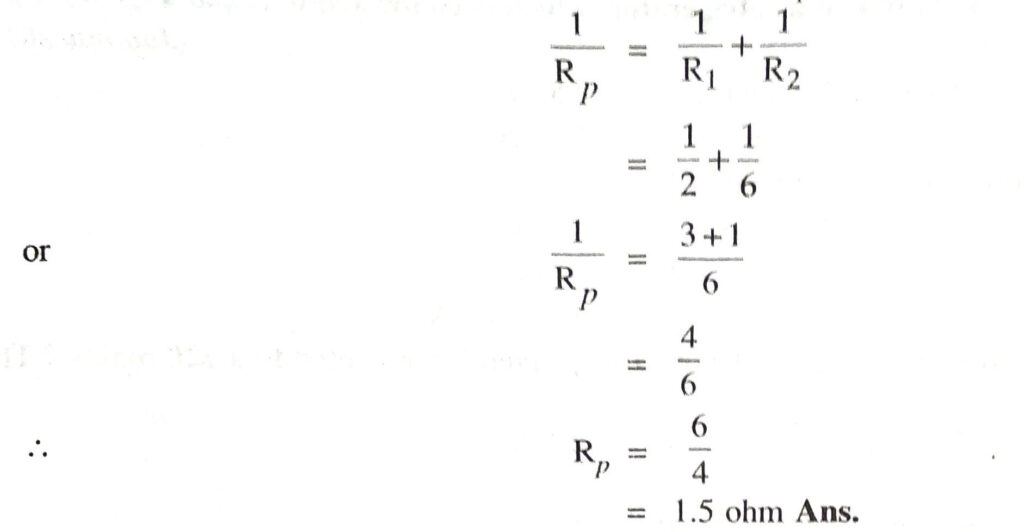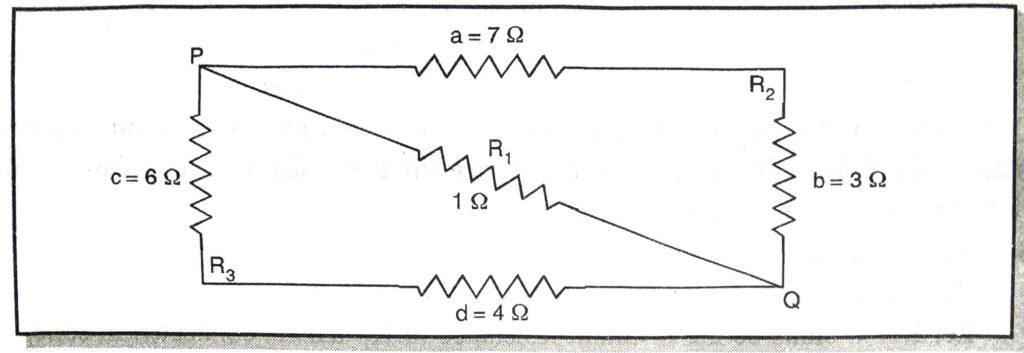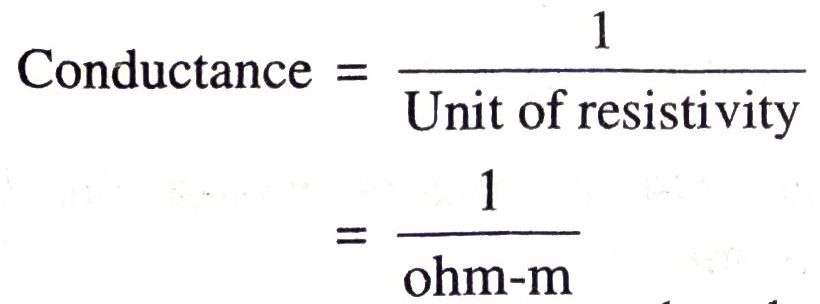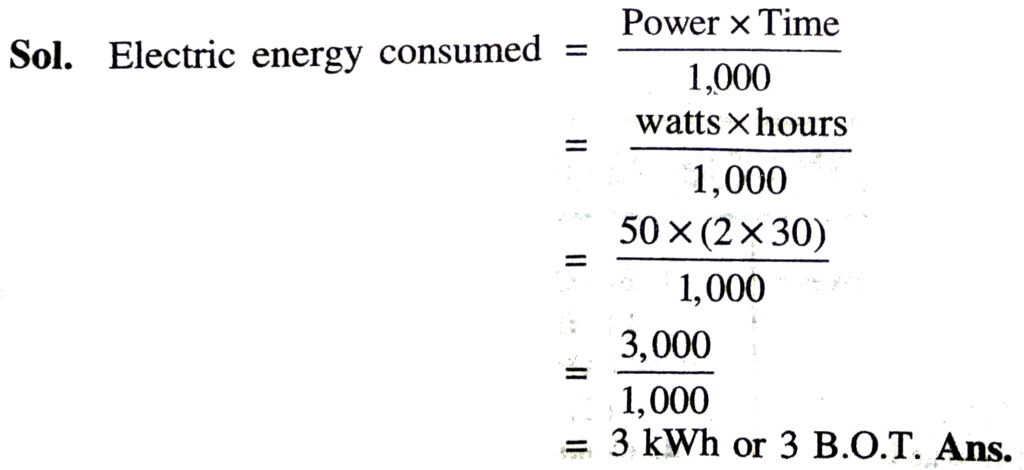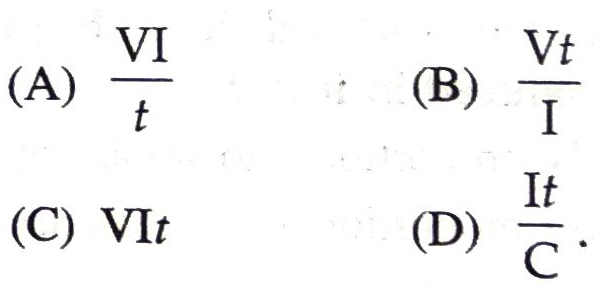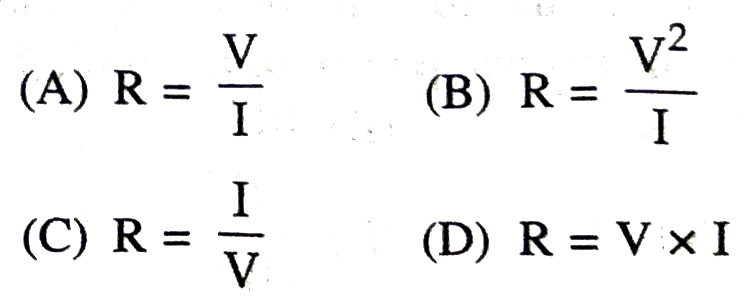JKBOSE 10th Class Science Solutions Chapter 3 Electricity
JKBOSE 10th Class Science Solutions Chapter 3 Electricity
Jammu & Kashmir State Board JKBOSE 10th Class Science Solutions
J&K class 10th Science Electricity Textbook Questions and Answers
BASIS AND BASICS
◆ Electric current is the rate of flow of charge Q through the conductor or it is the charge Q flowing per unit time i.e.,
I = Q/t.
◆ Charge always flows from a body at a higher potential to a body at lower potential.
◆ Electrostatic potential determines the direction of flow of charge from one body to the other when they are brought in contact.
◆ Electrostatic potential at a point is defined as the amount of work done is bringing a unit positive test charge from infinity to that point.
◆ Conductors have large number of free electrons whereas insulators have very few free electrons. Motion of free electrons constitutes the electric current.
◆ An electric circuit is a closed path through which electrons flow readily.
◆ As per convention, the direction of current is taken as opposite to the direction of flow of electrons.
IMPORTANT TERMS AND FACTS TO MEMORISE
- Ohm’s law may be defined as “Physical conditions remaining the same, the current flowing through a conductor is proportional to the potential difference between two ends”.
V ∝ I
or I ∝ V
∴ V = RI, where R is constant called resistance.
- Resistivity or specific resistance of a conductor is also defined as the resistance of a conductor whose length is 1 m and area of cross-section is 1 m². It depends upon the nature of the conductor and the temperature.
- When a number of resistances are connected in series, the resistance of combination is equal to the sum of individual resistance i.e., Rs = R1 + R2 + R3 + ……….
TEXT BOOK QUESTIONS (SOLVED)
Q. 1. Name a device that helps to maintain a potential difference across a conductor.
Ans. Electric cell or battery is a device that helps to maintain a potential difference across the ends of a conductor. Chemical action within the cell generates the potential difference across the terminals of the cell.
Q. 2. What is meant by saying that the potential difference betwen two points is 1 V ?
Ans. The potential difference between two points in a current carrying conductor is said to be 1 V if 1 joule of work is done in moving a charge of one coulomb (1 C) from one point to the other.
i.e. 1V = 1J/1C
or 1V = 1 JC-1
Q. 3. How much energy is given to each coulomb of charge passing through a 6 V battery?
Sol.
Energy to be given to 1 C of charge to pass through 1 V potential difference = 1 J.
∴ Energy to be given to 1C of charge to pass through 6 V battery = 6 J
or W = V x Q
= 6 volt x 1 coulomb
= 6 J/C x 1C
= 6 J. Ans.
Q. 4. On what factors does the resistance of a conductor depend ?
Or
What is the resistance of a conductor ? State the factors on which resistance of a conductor depends ?
Or
Name the factors affecting resistance.
Ans. Resistance of a conductor. It is the opposition offered by it to the flow of electricity through it.
Factors affecting resistance of a conductor. Resistance R of a conductor depends upon:
(i) Length of the conductor: It has been experimentally observed that :
R ∝ l, the length of the wire
(ii) Area of cross-section of the conductor :
i.e. R ∝ 1/A, where A is the area cross-section of the wire Combining above, we have :
R ∝ l/A
(iii) Nature of material of the conductor :
or R = ρ l/A
where p is a constant called specific resistance or electric resistivity of the material of the conductor.
If 1 = 1, A = 1, ρ = R.
i.e., specific resistance (or electric resistivity) of a conductor is the resistance of a wire of unit length and a unit area cross-section. It may be defined as :
Specific resistance of a conductor is the resistance of unit cube of the conductor.
(iv) Temperature of conductor : Resistance of conductor increases with the increase of temperature.
Unit of Specific Resistance (ρ): ρ = RA/l
= ohm m²/m = ohm m.
Q. 5. Will the current flow more easily through a thick wire or a thin wire of the same material when connected to the same source ? Why ?
Ans. We know that the resistance of a wire is inversely proportional to the area. Therefore, the thicker the wire, more is the area and lesser the resistance. Thus, current will flow more easily through a thicker wire than through thin wire of the same material.
Q. 6. Let the resistance of an electrical component remain constant while the potential difference across the two ends of the component decreases to half the former value. What change will occur in the current through it ?
Ans. According to Ohm’s law, physical conditions remaining constant, V ∝ I where V is the potential difference across the ends of conductor and I, the current flowing through it.
When potential difference is halved, the current will also be halved since resistance remain constant.
Q. 7. Why are coils of electric toasters and electric irons made of an alloy rather than that of a pure metal ?
Ans. Resistivity (specific resistance) of alloys is much higher than pure metals. Moreover, alloys also do not oxidise readily at very high temperatures. The alloys are, therefore, commonly used in making coils of electric heating devices like electric iron, electric toasters etc.
Q. 8. (a) Which among iron and mercury a better conductor ?
(b) Which material is best conductor ?
Or
Iron has electrical resistivity of 10.0 × 10-8 Ω m and mercury has electrical resistivity of 9.04 × 10-8 Ω m. Which is the better conductor and why?
Ans. (a) Resistivity of iron is 10 × 10-8 ohm-m and that of mercury 94 x 10-8 ohm-m, therefore, iron is a better conductor as compared to mercury.
(b) As compared to iron, silver has low electrical resistivity of 9.04 × 10-8 ohm-m, so silver is the best conductor.
Q. 9. Draw schematic diagram of a circuit consisting of a battery of three cells of 2 V each, a 5 Ω resistor; an 8 Ω resistor and 12 Ω resistor and a plug key, all connected in series.
Ans. Schematic diagram of the circuit.
Q. 10. Redraw the circuit in Q. 1 above putting an ammeter to measure the current through the resistors and voltmeter to measure the potential difference across 12 Ω resistor. What would be the reading in the ammeter and the voltmeter ?
Sol.
Modified circuit is as shown in Fig. Since 5Ω, 8 Ω and 12 Ω are connected in series, therefore, total resistance in series :
(Rs) = R1 + R2 + R3
= 5+ 8 + 12 = 25 Ω
Now, Total Current through the circuit, I = V/R
= 6/25
= 0.24 A
∴ Reading of ammeter = 0.24 A Ans.
P.D. across 12 Ω i.e., reading of voltmeter
V = I x R
= 0.24 x 12
⇒ V = 2.88 Ω Ans.
Q. 11. Judge the equivalent resistance when the following are connected in parallel
(a) 1 Ω and 106 Ω2; (b) 1 Ω and 103 Ω and 106 Ω.
Sol. (a) Here, R₁ = 1 Ω and R₂ = 106 Ω
When resistances are connected in parallel.
Q. 12. An electric lamp of 100 Ω, a toaster of resistance 50 Ω and a water filter of resistance 500 Ω are connected in parallel to a 220 V source. What is the resistance of the electric iron connected to the same source that takes as much current as all the three appliances and what is the current through it ?
Sol. Combined resistance of 100 Ω, 50 Ω and 500 Ω in parallel i.e., Rp is given by :
∴ Resistance of electric iron, Rp = 31.25 Ω Ans.
Current through electric iron, I = V/R
= 220/31.25
∴ I = 7.04 A Ans.
Q. 13. What are the advantages of connecting electric devices in parallel with the battery instead of connecting them in series?
Ans. When connected in parallel, all the electric devices are connected to the same potential difference but they draw different current. Moreover, in parallel arrangement if one electric device fails to work, the other devices are not affected. But when connected in series, the potential is divided between the different devices. In case, if one device is switched off or slops working, the other devices also do not work.
Q. 14. How can three resistors of resistance 2 Ω, 3 Ω and 6 Ω be connected to give a total resistance of (a) 4 Ω ; (b) 1 Ω ?
Sol.
(a) When all the three resistors are connected in series, the total resistance will be equal to the sum of all the three resistances.
i.e. Rs = 2Ω + 3Ω +6Ω
= 11Ω this arrangement is rejected.
Therefore, when 3 Ω and 6 Ω are in parallel
Rp‘ = 2 Ω It is in series with 2 Ω.
∴ Total resistance when 3 Ω, 6 Ω in parallel are in series with 2 Ω is = Rp‘ + 2 = 2 + 2 = 4 Ω as given in Fig.
If all the three resistances are in parallel, then
Q. 15. What is the (a) highest; (b) lowest total resistance that can be secured by combination of four coils of resistances 4 Ω, 8 Ω, 12 Ω, 24 Ω ?
Sol.
(a) Total resistance will be maximum when all the four resistances are connected in series. Let Rs be the total resistance in series combination
Rs = R1 + R2 + R3
4Ω + 8Ω + 12Ω + 24Ω
∴ Highest resistance = 48 Ω Ans.
(b) Total resistance will be lowest when all the four given resistance are connected in parallel. Let RP be the total resistance in parallel combination,
Q. 16. Why does the cord carrying an electric current does not glow while heating element does ?
Ans. Heating effect = I²R where I is the current flowing and R is the resistance. Current I is the same both in cord and in heating element.
Resistance R of the cord is negligible since it is made of copper (which has very less resistivity) while heating element is made of nichrome whose resistivity is 6,000 times more than copper. Nichrome gets heated up much more than copper. Therefore, heating element glows.
Q. 17. Compute the heat generated while transferring 96,000 C of charge in one hour through a potential difference of 50 V.
Sol.
Here, Quantity of charge (q) = 96000 C transferred in 1 hr.
Potential difference. 50 V
Work done to transfer Q coulomb of charge through potential difference W = VQ joule
W = 50 × 96,000
= 48,00,000 J
W = 4.8 x 106 J
∴ Heat produced = Work done in transferring the charge
= 4.8 x 106 J Ans.
Q. 18. An electric iron of resistance 20 Ω takes a current of 5A. Calculate the heat developed in 30 s.
Sol.
Here, Resistance, R = 20 Ω ; I = 5 A; t = 30 s.
We know, heat produced H = 12 Rt
= 52 x 20 x 30
= 15,000 J Ans.
Q. 19. What determines the rate at which the energy is delivered by a current ? Ans. Rate at which energy is delivered by the current is called power. It is measured in watt or in kilowatt.
Q. 2. An electric motor takes 5 A from a 220 V line. Determine the power of the motor and the energy consumed in 2 h.
Sol.
Here, current (I) = 5A
Potential difference (V) = 220 V
Time (t) = 2h
= 2 x 60 x 60 s
But Power (P) = VI
= 220 × 5
= 1,100 W
Energy consumed in 2 h (2 × 60 x 60 s), E = Pt
E = (1,100) (2 × 60 × 60)
= 7,920,000 J
∴ E = 7.92 x 106 J Ans.
TEXT BOOK EXERCISES (SOLVED)
Q. 1. A piece of wire of resistance R is cut into five equal parts. These parts are then connected in parallel. If the equivalent resistance of this combination is R’, then the ratio R/R’ is (a) 1/25 ; (b) 1/5; (c) 5; (d) 25.
Sol.
On cutting wire of resistance R into five equal parts, the resistance of each part is R/5. Let the total resistance be R’ of 5 resistors each of resistance R/5 connected in parallel.
Hence answer (d) 25 is correct.
Q. 2. Which of the following terms does not represent electrical power in the circuit ? (a) I²R; (b) IR²; (c) VI; (d) V²/R ?
Ans. All the three (a), (c) and (d) represent power. Therefore, only (b) IR² does not represent power. 390
Q. 3. An electric bulb is rated 220 V and 100 W. When operated on 110 V, the power consumed will be (a) 100 W; (b) 75 W; (c) 50 W; (d) 25 W.
Sol.
Hence (d) 25 W is correct answer.
Q. 4. Two conducting wires of the same material and of equal lengths and equal diameters are first connected in series and then in parallel in an electric circuit. The ratio of heat produced in series and parallel combination would be (a) 1 : 2 (b) 2:1 (c) 1: 4 (d) 4:1
Sol.
Since the wires are of the same material and are equal in lengths and diameters, therefore, if R is resistance of each. Let total resistance in series and parallel be Rs and Rp respectively, when connected in series ;
Hence, (c) 1 : 4 is correct answer.
Q. 5. How is a voltmeter connected in the circuit to measure potential difference between two points ?
Ans. Voltmeter is always connected in parallel between two points across which the potential difference is required to be measured.
Q. 6. A copper wire has diameter 0.5 mm and resistivity 1.6 × 10-8 Ω m. What will be the length of this wire to make its resistance 10 Ω ? How much does the resistance change if the diameter is doubled ?
Sol.
If the diameter of wire is doubled, resistance will become 1/4th of the original resistance.
since R ∝ 1/A
or R ∝ 1/d²
Decrease in resistance will be = 10 – 10/4
= 10 – 2.5
= 7.5 ohm. Ans.
Q. 7. The values of the current I flowing in a given resistor for corresponding values of potential difference V across the resistor are given below :
| I (amperes) |
0.5 |
1.0 |
2.0 |
3.0 |
4.0 |
| V (volts) |
1.6 |
3.4 |
6.7 |
10.2 |
13.2 |
Plot a graph between V and I and calculate the resistance of that resistor.
Sol.
Graph between I and V is as shown in Fig. It is almost a straight line.
Resistance is the slope of I-V graph.
Q. 8. When a 12 V battery is connected across an unknown resistor, there is a current of 2.5 mA in the circuit. Find the value of the resistance of resistor ?
Sol.
Here, I = 2.5 mA = 2.5 x 10-3 A; V = 12 volts ; R = ?
We know from ohm’s law
Q. 9. A battery of 9 V is connected in series with resistors of 0.2 Ω, 0.3 Ω, 0.4 Ω, 0.5 Ω and 12 Ω respectively. How much current will flow through a 12 Ω resistor ?
Sol.
Resistors are connected in series
∴ Total Resistance, Rs = 0.2 + 0.3 + 0.4 + 0.5 + 12 = 13.4 Ω
Potential Difference V = 9 V
When in series, the current passing through each resistor is equal to the current in the circuit
∴ Current through 12 Ω = 0.67 A Ans.
Q. 10. How many 176 2 resistors in parallel are required to carry 5A on a 220 V line?
Sol.
Here R = 176 Ω
V = 220 V
I = 5 A
Resistance of parallel combination Rp = V/I
Rp = 220/5
= 44 Ω
If n resistors each of resistance R are connected in parallel, then net resistance Rp is :
4 resistors each 176 Ω connected in parallel will result in net resistance of 44 Ω causing a current of 5A to flow through when connected to 220 V.
Q. 11. How will you connect three resistors, each of resistance 6 Ω, so that the combination has a resistance of (i) 9 Ω; (ii) 4 Ω ?
Sol.
(i) When two resistors each of 6 Ω are connected in parallel give resistance Rp
When this combination is connected in series with third resistor of 6 Ω, it gives a total resistance
R = Rp + 6 Ω
= 3 Ω + 6 Ω
= 9 Ω Ans.
(ii) When two resistors each of 6 Ω are connected in series, it gives rise to resistance Rs = 6 + 6 = 12 Ω. This 12 Ω when connected in parallel with 6 Ω gives total resistance Rp‘
Q. 12. Several electric bulbs designed to be used on a 220 V electric supply line are rated 10 W. How many lamps can be connected in parallel with each other across the two wires of 220 V line if the maximum allowable current is 5 A ?
= 220 x 220/10
= 4840 Ω
Let ‘n’ be the number of bulbs of 4840 Ω resistance each connected in parallel. Their equivalent resistance Rp is given by;
So, 110 bulbs can be connected in parallel (with each other across two wires).
Q. 13. A hot plate of an electric oven connected to a 220 V line has two resistance coils A and B, each of 24 Ω resistance, which may be used separately, in series or in parallel. What are currents in three cases ?
Sol.
(i) When two coils A and B each of 24 Ω are used separately
R = 24 Ω and V = 220 V
Q. 14. Compare the power used in 2 Ω resistor in each of the following circuits :
(i) a 6 V battery in series with 1 Ω and 2 Ω resistors and
(ii) a 4 V battery in parallel with 12 Ω and 2 Ω resistors.
Sol.
(i) Here R₁ = 1 Ω ; R₂ = 2 Ω
when connected in series the resultant resistance, R = R₁ + R₂
= 1 Ω + 2 Ω
= 3 Ω
∴ Current through each resistor and also total current
= 4 x 2
P2 = 8 W Ans.
It is seen that P₁ = P₂ = 8 W
The Power consumed by 2 Ω resistor in each case is 8 W.
Q. 15. Two lamps, one rated 100 W at 220 V and other 60 W at 220 V, are connected in parallel to electric main supply. What current is drawn from the line if the supply voltage is 220 V ?
Q. 16. Which uses more energy, a 250 W TV set for 1 hour or a 1,200 W toaster for 10 minutes ?
Sol.
(i) Energy consumed when TV set of 250W is used for 1 hr.
E₁ = P₁ x t₁
= 250 W x1h
E₁ = 250 Wh Ans.
(ii) Energy consumed when 1200 W toaster is used for 10 minutes.
t2 = 10 minutes
= 10/60 h
E₂ = P₂ x 1₂
= 1,200 W x 10/60 h
i.e. E2 = 200 Wh
∴ E2 = 720,000 J
From (i) and (ii) E1 > E2
Therefore, 250 W TV set consumes more energy than a toaster of 1200 W. Ans.
Q. 17. An electric heater of resistance 8 Ω draws 15 A from service mains for 2 hours. Calculate the rate at which heat is developed in the heater.
Sol.
Given R = 8 Ω, I = 15A and Time t = 2 hrs.
∴ Rate at which heat is developed in the heater, its electric power,
P = 1²2 x R
= 15² x 8
= 225 × 8
i.e P = 1,800 W or J s-1 Ans.
Thus, 1,800 joule of heat is developed per second.
Q. 18. Explain the following:
(a) Why is the tungsten used almost exclusively for filament of electric lamps ?
(b) Why are the conductors of electric heating devices, such as bread toasters and electric irons, made of an alloy rather than pure metal ?
(c) Why is series arrangement not used for domestic circuits ?
(d) How does the resistance of a wire vary with its area of cross-section ?
(e) Why are copper and aluminium usually employed for electricity transmission ?
Ans. (a) Melting point of tungsten is very high and also its resistance is high. Hence tungsten can be heated to very high temperature. Due to its high resistance, large quantity of heat is produced which makes it glow.
(b) Resistivity of alloys is very large as compared to pure metals. Moreover, alloys donot oxidise (burn out) easily as compared to pure metals. Therefore, conductors of electric heating devices are made of alloys.
(c) When electric appliances are connected in series, the equivalent resistance will be very large as
Req = R1 + R2 + R3 + R4 + …………. Due to high equivalent resistance huge quantity of heat is produced in the domestic circuit which may result in fire. This is why series arrangement is not used in domestic circuits.
(d) Resistance of a conductor is inversely proportional to its area cross-section.
(e) Copper and aluminium have low resistivity and as such there will be small loss of energy when a certain current flows through them. Therefore, copper and aluminium wires are used for electricity transmission.
ADDITIONAL IMPORTANT QUESTIONS
LONG ANSWER TYPE QUESTIONS
Q. 1. What is the need of combining different resistors ? What is the resultant resistance when a number of resistances are connected in series?
Or
State Ohm’s law. Find the equivalent of resistances of the individual resistances connected in series.
Ans. Ohm’s law, Refer Long Answer Type Questions, Q. 3.
Combination of Resistors. Resistors of all values of resistances are not available. Hence resistors are connected in a number of ways to increase or decrease the combined resistance. There are two distinct ways in which resistors can be connected. They are (i) resistors in series and (ii) resistors in parallel.
RESISTORS CONNECTED IN SERIES
Resistors are said to be connected in series, if they are joined end to end so that the same current flows through each one of them in succession. Let the resistors R₁, R₂ and R3, be joined in series and let the current passing through them be I [Fig. ].
Let V₁, V₂ and V3 be the potential difference between the ends of the first, second and third resistor respectively.
By Ohm’s law,
V1 = IR1; V2 = IR2 and V3 = IR3
If V is the total potential difference between the ends A and D and Rs is the effective resistance of the combination of all the resistors, then
V = IRS
But Vs = V₁ + V₂ + V3
or IRs = IR₁ + IR₂ + IR3
IRs = I(R₁ + R₂ + R3)
or Rs = R₁ + R₂ + R3
The above result holds good for any number of resistors joined in series.
Thus when resistors are joined in series, the total resistance is equal to the sum of individual resistances.
Q. 2. With the help of a diagram derive the formula for the equivalent resistance of three resistances connected in parallels.
Or
Find the equivalent resistance of the resistances connected in parallels.
Or
What do you understand by Resistances in Parallel ? Derive an expression for the same.
Ans. Combination of Resistances in Parallel. A circuit in which two or more resistors are connected across two common points so as to provide separate paths is called parallel circuit.
In this case, the same potential difference will be maintained between the two ends of every resistor and the current will divide itself in various branches.
Derivation of expression for resistances in parallel :
Let the resistors R₁, R₂ and R3 be joined in parallel between the points A and B. Let the current I reaching A divide itself into three parts I₁, I₂ and I3 along R₁, R₂ and R3 respectively. Let V be the potential difference between the points A and B. The currents flowing in the individual resistors are then given by :
The result holds good for any number of resistances.
Q. 3. State and explain Ohm’s Law.
Or
State Ohm’s Law. Explain it with the help of a circuit diagram.
Ans. Ohm’s Law. George Simon Ohm found the relationship between current I, flowing in a metallic wire and the potential difference across its terminals. According to this law, the potential difference V, across the ends of a given metallic wire (conductor) in an electric circuit is directly proportional to the current flowing through it, provided its temperature remains the same.
In other words, V ∝ I
or V/I = constant
or V/I = R, where R is constant
for wire and is called resistance of the conductor. To explain this consider the following activity.
Set up the circuit consisting of nichrome wire X; an ammeter, a voltmeter and four cells each of 1.5 V.
First use only one cell as the source of current and note the reading of ammeter, I for current and voltmeter, V for potential difference across the wire. Find the ratio of V and I.
Next connect two cells in the circuit and note the readings of voltmeter and ammeter for the values of potential difference and current. Find the ratio of V and I. Repeat the above steps by using three and then four cells in circuit separately. Calculate the ratio of V and I for each. It will be found that in each case the same value for V/2 is obtained. This shows that as V increases in the circuit for wire of same resistance the current I also increases accordingly so that the ratio V/I remains constant.
Q. 4. What is Ohm’s law? How can it be verified ?
Ans. Ohm’s law. It states that the current passing through a conductor is directly proportional to the potential difference across its ends provided the temperature and other physical conditions remains unchanged.
I ∝ V
i.e. V ∝ I
or V = RI
Where R is a constant of proportionalty called resistance.
Resistance. It is the property of a conductor to oppose the flow of current. Resistance depends upon the nature of the conductor, its temperature and its dimensions (length, area).
R = V/I
or I = V/R
Experimental Verification of Ohm’s Law. Connect an ammeter, battery, key and rheostat as shown in Fig. 3.8. Put the plug in the key K. Read the values of potential difference across resistor R with the help of voltmeter V and the current flowing through the resistor with the help of ammeter.
Note the readings. Vary the current in the circuit by sliding contact of rheostat and go on noting reading in voltmeter and ammeter. Now plot a graph between V and I on graph paper. It will be straight line graph as shown in Fig. (b). which verifies that V ∝ I.
Q. 5. What is SI unit of resistance ? What is meant by Ohmic and non-ohmic circuits ?
Ans. Unit of Resistance
R = V/I
If V = 1 volt; I = 1 ampere
then R = 1 ohm
i.e. the resistance of a substance is 1 ohm (or 1 Ω) if 1A of the current flows through it when a potential difference 1V is applied across its ends.
Ohmic and Non-Ohmic Circuits : Ohmic or a linear circuit is one in which a graph between potential difference V and current I is a straight line. A circuit containing a resistor is an ohmic or linear circuit. The resistance of ohmic circuit is a constant and does not change with voltage. Graph between V and I is a straight line as shown in Fig.
A non-ohmic or non-linear circuit is one in which the resistance varies with applied voltage i.e., the graph between V and I is not linear. Rectifiers, discharge tubes and vacuum tubes are non-ohmic or non-linear circuits [Fig.].
Q. 6. What is meant by Joule’s heating effect due to flow of current through a conductor?
Ans. The conductors offer some resistance to the flow of current. If I is the current in ampere flowing for t second, then quantity of charge Q = I x t.
The work done in carrying a charge Q (= It), coulomb against a potential difference of 1 volt.
SHORT ANSWER TYPE QUESTIONS
Q. 1. What is the potential difference between two points in the electric field ? Name and define its SI unit.
Or
Define potential difference and derive the relation V = W/Q. Give its units.
Ans. Let a charge Q be moved from one point to another point, in the electric field and w be the work done, then the potential difference V between two points is given by :
Definition of Potential difference. The potential difference between two points in the electric field is defined as the amount of work done in moving a unit positive test charge from one point to the other against electrostatic force due to electric field.
SI units of P.D. is Volt.
Potential difference between two points is said to be 1 Volt if 1 J Volt of the work is done in moving a charge of 1 C from one point to the other.
Q. 2. What is an electric circuit ?
Ans. Electric circuit. It is a closed path through which the electrons flow readily. When a conductor is connected to a battery, the electrons move from negative terminal of the battery to the positive terminal. However, conventionally, the current is considered to flow from positive to negative terminal of battery.
Q. 3. Draw the symbols of some commonly used components in circuit diagram. (only eight).
Ans. Symbols of some commonly used components in circuit.
Q. 4. Distinguish between good conductors, resistors and insulators.
Ans. Good Conductors. Those substances through which the current can flow freely.
Insulators. Those substances which do not allow the current to flow through them.
Resistors. These are objects which oppose the flow of current through them.
Q. 5. Calculate the cost of seeing 2 movies on colour T.V. daily for the month of September? Given wattage of colour T.V. = 60 W, duration each movie is 2h 30 min and 1 kWh costs Rs. 7.
Sol.
Wattage of colour T.V. = 60 W
Q. 6. What is meant by electric power? Give its units. Also give its SI unit.
Or
What is power? Give commercial unit of power.
Or
What is meant by electric power ? Give its units.
Ans. Electric Power. Power is the rate of doing work. The electric power of an appliance is its rate of consumption of electric energy.
The power of an electric appliance is 1 W (watt) if it consumes 1 J (joule) of energy in 1 second. If I ampere of the current flows for t second through a coil whose ends are maintained at a potential difference of V volt, then the energy consumed or the work done.
Q. 7. Define electric current and give its SI unit.
Or
Give the quantitative definition of electric current.
Ans. Electric current. The rate of flow of charge in a conductor is called electric current.
SI unit of electric current is ampere (A). Current flowing in a conductor is said to be 1A if 1C of charge flows through the conductor in 1s.
Q. 8. Define the terms of the following:
(a) Potential difference
(b) Electric Current
(c) Electric Power
(d) Heating effect due to electric current.
Ans. (a) Potential difference. The potential difference between two points in an electric field is defined as the amount of work done in moving a unit positive test charge from one point to the other against electrostatic force due to electric field. S.I. unit of potential difference is volt.
(b) Electric current. Refer Q. 7 Page (SAQ).
(c) Electric Power. The electric power of an appliance is its rate of consumption of electric energy.
S.I. unit of Power is watt.
(d) Heating effect due to electric current. Refer Q. 6.
Q. 9. Define the terms Electricity and Current Electricity.
Ans.Electricity. It is a fundamental form of energy observable in positive and negative foms that occurs naturally (as in lightning) or is produced (by rubbing two bodies together) in a generator and expressed in terms of movement and interaction of electrons.
Current Electricity. It is a stream of charged particles such as ions or electrons through a region (a unit cube) of conductor in a unit time.
Q. 10. What do you mean by bulb rating?
Ans. Power is the rate of work done or energy conserved and converted into heat and light in 1 second.
If a bulb is rated as 240 V, 60 W then it means the bulb operated at a potential difference of 240 V it would glow at normal brightness and will convert 60 J of energy into heat and light in 1 second.
Hence a bulb rated 240 V, 60 W would glow brighter than another bulb rated 240 V, 30 W :
Q. 11. What is electric energy? What is its SI unit ?
Ans. Electric energy. It is the total amount of work done by the current in a given time or electric energy is the total amount of energy consumed in an electric circuit in a given time.
W (joule) = P(watt) x t (second)
Practical Unit of Electric Energy. Practical unit of electric energy called kWh (kilowatthour) is usually used. This unit is also called B.O.T. (Board of Trade Unit).
The unit kWh is equal to the work done or energy consumed when a power of 1kW is consumed for 1 hour.
Q. 12. Why are coils of electric toasters and electric irons made of an alloy rather than a pure metal ?
Ans.Preference of Pure metal rather than alloy as coils of electric toasters and Electric Irons. Refer Q. 18 (b).
Q. 13. Wires used in electric fitting are mostly made up of copper. Why ?
Ans.As copper is good conductor of electricity and has low resistivity the energy used is 20A more in transferring electricity than producing heat.
Q. 14. If the resistance is doubled. What happens to current in a circuit ?
Ans. The current in the circuit is halved, when the resistance in the circuit is doubled.
Q. 15. Distinguish between an open and closed circuit.
Ans. Open circuit. An open circuit is a circuit where the energy is not flowing through it (i.e. circuit is not drawn from the battery.
Closed circuit. It is circuit where the energy is allowed to flow through it (i.e. energy is made to flow from a source (battery) in the desired end point of the circuit.
Q. 16. Write at least two points of difference between Resistor and Resistance.
Ans. Resistance. It is the property of a conductor which determines the quantity of current that passes through it when potential difference is applied across it.
Resistor. It is an electrical component with a predetermined electrical resistance like 1 ohm, 10 ohms, 100 ohms etc.
Q. 17. What do you mean by heating effect of current ? Write down applications of (Jammu Winter Zone 2021) heating effects of current.
Ans. Heating Effect of Current. When an electric current passes through a conductor (resistance wire), the material of the conductor opposes the flow of current. The work done in overcoming the flow of current produces heat so that the conductor becomes hot after some time and produces heat. This is called heating effect of current.
Example. A bulk becomes hot after its use for sometime.
Applications of Heating Effect of Current. The heating effect of current is widely used in our day-to-day activities where electric iron, heater, electric kettle, toaster, geseyer, fuse and fan etc. are used as alternatives to the conventional methods of cooking, washing, bathing, lighting.
Q. 18. Draw a circuit diagram of Ohm’s law apparatus.
Ans. Circuit diagram of Ohm’s law apparatus.
NUMERICAL PROBLEMS
Q. 1. Current of 100 mA flows through the filament of an electric bulb for 30 minutes. Calculate the charge that flows through the circuit.
Sol.
Given : Current, I = 100 mA
= 0.1 A
Time, t = 30 min
= 30 x 60 s
=1800 s
Charge flowing through the circuit, Q = I x t
= 0.1 A x 1800 s
= 180 C Ans.
Q. 2. 60 coulomb of charge flows through a circuit for 5 minutes. Calculate the current flowing in a circuit.
Q. 3. The potential difference between the terminals of an electric heater is 60 V. When it draws current of 4A from the source, what current heater will draw if potential difference is increased to 120 V ?
Sol.
Given First case
Current drawn by heater, I₁ = 4A
Q. 4. Calculate the area of cross-section of wire whose length is 1.0 m and resistance is 23 Ω. Take specific resistance of the material of wire as 1.84 x 10-6 ohm-m.
Q. 5. A wire of 4Ω resistance is doubled (bent to make half of its original length). Calculate the new resistance of the wire ?
Sol.
Suppose the original length of the wire(l₁) = l (say)
Area of cross-section of the wire (A₁) = A
Resistance of the wire (R₁) = 4 Ω
Since the material of the wire is same, therefore, its resistivity will remain the same and let it be ρ
Q. 6. A wire of 10 Ω resistance is bent form a closed circle. What will be the effective resistance between two end points of any diameter of the circle ?
Sol.
The end points A and B of the circle divide the circle into two equal resistances.
Resistance of each part R₁ = R₂
= 10/2 = 5 Ω
These two resistances can be imagined to have been connected in parallel.
Let Rp be the effective resistance of the parallel combination, then
Q. 7. Resistance of a metal wire of length 1 m is 26 Ω at 20°C. If the diameter of the wire is 0.3 mm, what will be the resistivity of the metal at that temperature ? Using standard table of resistivity of various metals, predict the material of the wire.
Sol.
Given Resistance of the wire (R) = 26 Ω
Looking from the Table 3.2 of Text Book we find that this resistivity corresponds to manganese.
Q. 8. From the given labelled circuit diagram, find :
(a) Resultant resistance of the circuit
(b) Current flowing in the circuit.
Sol.
(a) Suppose R’ is the equivalent resistance of the parallel arrangement of resistors 3Ω, 3Ω and 39 between points B and C, then ;
Let R be the total resistance of series combination of 4Ω between A and B and R’ = 1Ω between B and C, then
Q. 9. (i) In an electric circuit, a battery of five cells each of 2V, resistors of 5Ω, 10Ω and 15Ω and a key plug are connected in series arrangement. Draw its schematic diagram.
(ii) Calculate the value of current flowing in this circuit when plug is introduced in the key.
Sol.
(i) Schematic Diagram of the Circuit
(ii) Three resistors of 5Ω, 10Ω and 15Ω when joined in series have resultant resistance R, then ;
Q. 10. In the alongside figure 6 V battery is connected to the shown arrangement of resistance. Calculate :
(i) Effective resistance of this arrangement
(ii) Total current flowing in the circuit.
Sol. (i)
Resistance of branch AB, R₁ = 5 + 5 = 10 Ω
Resistance of branch CD, R₂ = 10 Ω + 10 Ω
= 20 Ω
Now, branches AB and CD are connected in parallel. If R is the total resistance, then
Q. 11. An electric lamp, whose resistance is 20 Ω and a conductor of 4 Ω resistance are connected to a 6 V battery as shown in the figure. Calculate (a) total resistance of the circuit (b) the current through the circuit (c) the P.D. across the electric lamp and conductor.
Sol.
Given : Resistance of lamp R₁ = 20 Ω
and Resistance of conductor R₂ = 4 Ω
Pot. difference of battery V = 6V
(a): both the resistances are connected in series,
∴ Total resistance of the circuit R = R₁ + R₂
= 20 Ω + 4 Ω
= 24 Ω Ans.
(b) Total potential difference in the circuit V = 6V
Total resistance in the circuit, R = 24 Ω
Q. 12. An electric iron consumes energy at a rate of 880 W when heating is at the maximum rate and 440 W when the heating is at the minimum. The voltage is 220 V. What are the current and resistance in each case ?
Sol.
(a) When heating is at the maximum rate.
= 220V/2A
= 110 Ω
Q. 13. 98 J of heat is produced each second in 2Ω resistor. Find the potential difference.
Q. 14. The rating of an electric heater is 1100 W; 220V. Calculate the resistance when it operates at 220 V. Also calculate the energy consumed in kWh in the month of November, if the heater is used daily for 4 hours at the rated voltage.
Q. 15. What possible values of the resultant resistance one can get by combining two resistances one of value 2Ω and the other of 6 Ω ?
Sol.
Here R₁ = 2 Ω ; R₂ = 6 Ω
Combined resistance R, when connected in series is
Rs = R₁ + R₂
= 2 Ω + 6
Ω = 8 ohm Ans.
When connected in parallel, the combined resistance Rp, is
Q. 16. A household uses the following electric appliances :
(i) Refrigerator of rating 400 W for 10 hours each day
(i) Two electric fans of rating 80 W each for 12 hours each day
(iii) Six electric tubes of rating 18 W each for 6 hours each day. Calculate the electricity bill of the household for the month of April if the cost per unit of electric energy is Rs. 4.00.
Sol.
Electric energy consumed by all appliances working together each day
= (400 x 10) + (2 x 80 x 12) + 6 × 18 × 6
= 4000 Wh + 1920 Wh + 648 Wh
= 6568 Wh
= 6.568 kWh (units)
Total electric energy consumed in 30 days of April = 6.568 x 30 units
= 65.68 × 3
= 197.04
Electricity Bill = 197.04 x 4
= Rs. 788.16 Ans.
Q. 17. An electric motor takes 5 A current from 220 V line. Determine the power of the motor and energy consumed in 2 hours.
Sol.
Given, V = 220 volt; I = 5 A
t = 2 hour 7,200 s
Power consumed = VI = 220 V x 5 A
= 1,100 watts
Energy consumed = VIt = 220V x 5 Ax 2 h
= 2,200 Wh
= 2.2 kWh
or in SI = 1,100 x 5 x 7,200 s
= 3.96 × 107 J
Q. 18. What is the Power of a refrigerator, which is connected to a 220 V generator? The current is 1.25 A.
Sol.
Potential difference, V = 220 V
Current, I = 1.25 A
Power of the refrigerator, P = ?
We know, P = V x I
P = 220 x 1.25
= 275 Watt Ans.
Q. 19. What is the power of an Electric Iron, which is connected to a 220 mains ? The current is 1.5 A.
Sol.
Potential difference, V = 220 V
Current, I = 1.5A
Power of Electric Iron, P = ?
We know Power, P = V x I
= 220 V x 1.5 A
= 330 Watt Ans.
Q. 20. Calculate the power of a bulb, which is connected to a 220 V source ? The current is 0.70 A.
Sol.
Potential difference, V = 220 V
Current, I = 0.70 A
Power of Bulb, P = ?
We know Power, P = V x I
= 220 V x 0.70 A
= 15.4 Watt Ans.
Q. 21. An electric bulb is connected to a 220 V generator. The current is 0.50 A. What is the power of the bulb ?
Sol.
Potential difference, V = 220 V
Current, I = 0.50 A
Power of the Bulb, P = ?
We know Power, P = V x I
= 110 Watt Ans.
Q. 22. How much work is done in moving a charge of ‘2C’ across two points having P.D. 12V ?
Sol.
Potential difference between two points, V = 12 V
Quantity of Charge moved across
two points, Q = 2C
Work done, W = ?
We know, work done in moving the charge, W = V x Q
= 12V x 2C
= 24 J Ans.
Q. 23. Two resistors R₁ and R₂ are connected in series in a circuit having the resultant resistance of 6 Ohms. If the value of resistance for the resistor R₂ is 2 Ohms, calculate the value of resistance for the resistor R₁.
Sol.
Here resistance of resistor R₁ = r₁ (say)
Resistance of resistor R₂ = r₂ = 2 ohms (given)
Let R 6 ohms be the resultant resistance of R₁ and R₂ connected in series.
In series arrangement, R = r₁ + r₂
6 = r₁ + 2
∴ r₁ = 6-2
Hence resistance of resistor R₁ = r₁ = 4 ohms Ans.
NUMERICAL PROBLEMS FOR PRACTICE
Q. 1. 40 Joules of work is done in moving a charge from a point at 230 volts to another point at 240 volts. Find the quantity of the charge.
Hint: P.D. = 240 V – 230 V = 10 V
W = 40 J, Use Q = W/V
Q. 2. The potential difference between two ends of a wire is 150 mV. The wire has a resistance of 50 Ω. Find the current flowing through the wire.
Hint: V = 50 mV = 0.150 V; R = 50 Ω, Use I = V/R
Q. 3. The resistance of a metal wire of length 224 and area of cross-section 1.55 × 10-6 −m s2 is 0.036 Ω. Calculate the resistivity of the metal.
Hint : L = 2 m; A = 1.55 × 10-6 m2; R = 0.036 Ω
Apply R = ρ l/A and calculate ρ.
Q. 4. Draw a schematic diagram of a circuit consisting of 24 V battery, a 10 ohm resistor, a 5 ohm resistor, 2 ohm resistor, an ammeter and a plug key, all connected in series. Calculate the ammeter reading in this circuit.
Hint: Draw circuit diagram by joining ammeter and three resistors in series through battery and key plug. Find total resistance of three resistors connected in series by applying
R = R1 + R2 + R3. Find I by applying I = V/R
Q. 5. Calculate the effective resistance between P and Q.
Hint: (i) In series
R2 = a + b
R3 = c + d
(ii) In parallel
calculate R
VERY SHORT ANSWER TYPE QUESTIONS
Q. 1. Is electric potential a scalar or a vector quantity ?
Ans. It is a scalar quantity.
Q. 2. What is the direction of electronic current ?
Ans. Electrons flow from negative to positive i.e., in the direction opposite to that of conventional current.
Q. 3. What is SI unit of conductance ?
Ans. Conductance is reverse of resistivity.
∴ S.I. Unit of conductance is = ohm-1 m-1 = Sm-1, where S stands for siemen.
Q. 4. What is practical unit of power and electric energy?
Ans. Practical unit of power is watt and that of electric energy is kWh (kilowatt-hour).
Q. 5. Which one is having more resistance, 100 W bulb or a 50 W bulb ?
Ans. Resistance of 50 W bulb is twice that of 100 W bulb.
Q. 6. Which is having more resistivity, a thick or a thin wire of same material ?
Ans. Resistivity depends upon the nature of substance and temperature. It doesn’t depend upon its dimensions i.e., length, area etc. Therefore, resistivity of both, a thick or a thin wire is the same.
Q. 7. Define electric charge and give its S.I. unit.
Ans. Electric charge. It is an intrinsic property of elementary particles. (Proton and Electron) of matter which gives rise to electric force of attraction or repulsion between various objects. S.I. unit of electric charge is coulomb (C).
Q. 8. A wire of resistance 2 has been connected to a source of 50 V at its two ends. What is the current flowing through the wire ?
Ans. Zero. Current flows due to potential difference and not due to potentials. In present case both the ends are at 50 V potential and hence P.D. between two ends is zero.
Q. 9. How resistance changes with increase of temperature ?
Ans.Resistance of conductor increases with the increase of temperature while that of semiconductors decreases with the increase of temperature.
Q. 10. What constitutes the current ?
Ans. Flow of free electrons constitute the current.
Q. 11. How does the mass of wire change when the current is flowing in the wire ?
Ans. It remains the same.
Q. 12. Name the physical quantity whose unit is JC-1.
Ans. It is potential difference or e.m.f. The other name of this is volt.
Q. 13. What is SI unit of resistivity?
Ans. It is ohm-m.
Q. 14. How many electrons are there in 1C of negative charge ?
Ans.These are

electrons in 1C of charge.
Q. 15. A bird sitting on an 11,000 V wire is quite safe but a man on earth touching 220 V wire may die. Why so ?
Ans. Death may be caused if a heavy current flows through the body. Current flows not due to potential of the body but due to potential difference between two ends. When a person is standing on earth, he touches a 220 V line hence the potential difference of two points is 220 V. Full body of a bird however is at 11,000 V potential but no current flows through it.
Q. 16. How many joules of energy is there in 1 kWh of energy?
Ans. 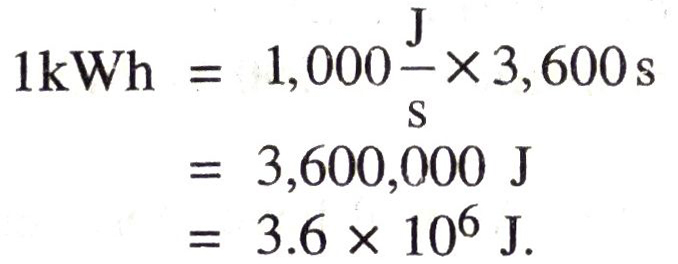
Q. 17. What is measured by an ammeter ?
Ans. An ammeter measures current.
Q. 18. What is measured by a voltmeter ?
Ans. Voltmeter measures potential difference.
Q. 19. A lamp consumes 50 W and is lighted 2 h daily in month of April. How many units of electric energy is consumed ?
Q. 20. What is the other name given to resistivity ?
Ans.Specific resistance.
Q. 21. Name one source of direct current.
Ans. Cell is a source of direct current.
Q. 22. Define electric power and give its SI unit.
Ans. Electric power. It is the rate of consumption of electric energy
SI unit of electric power is watt or Js-1.
Q. 23. Write mathematical expression for coulomb’s law.
Ans. 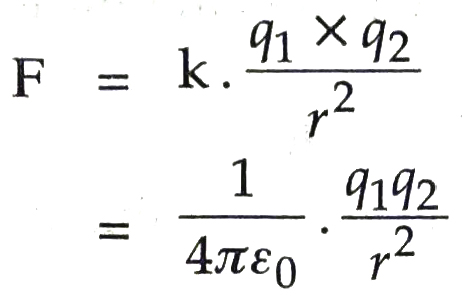
Q. 24. What happens to the current when resistance of conductor is doubled ?
Ans. The current flowing in the conductor becomes half of the previous value when its resistance is doubled.
Q. 25. If current is doubled, what will happen to the resistance of the conductor ?
Ans.The resistance of the conductor will not change as it does not depend on the amount of the current flowing through it.
Q. 26. Which combination of resistors reduces the equivalent resistance of the combination ?
Ans. In parallel arrangement of the resistors, the equivalent resistance of the combination gets reduced.
Q. 27. Name three electric devices that are based on heating effect of current.
Ans. (i) Electric heater (ii) Electric bulb (iii) Electric Iron.
Q. 28. Which one will have more resistance: a 100 W bulb or a 60 W bulb ?
Ans. Since R ∝ 1/ρ, therefore bulb of 60 W will have more resistance.
Q. 29. State Ohm’s Law in electricity.
Ans.Ohm’s Law. This law states that the current passing through a conductor is directly proportional to the potential difference across its ends provided the temperature and other physical conditions remain unchanged.
Q. 30. Write down the S.I. unit of current.
Ans. Ampere.
MULTIPLE CHOICE QUESTIONS
Select the correct answer out of the four alternatives :
1. Another way of writing volt is :
(A) JC-1
(B) J m-2
(C) JC
(D) JC-2.
Ans. (A) JC-1
2. Number of electrons in 1 C of charge is :
(A) 1.6 × 10-19
(B) 6.023 x 1023
(C) 6.25 x 1018
(D) 6 × 1024.
Ans. (C) 6.25 x 1018
3. For Ohmic resistors, the graph between V and I is :
(A) parabolic
(B) hyperbolic
(C) circular
(D) straight line.
Ans. (D) straight line.
4. Conductivity is measured in :
(A) siemen
(B) mho-1
(C) VA-1
(D) ohm-1 m-1.
Ans. (D) ohm-1 m-1.
5. Safety fuse wire is made of :
(A) copper
(B) silver
(C) alloy of tin and lead
(D) tungsten.
Ans. (C) alloy of tin and lead
6. Filament of electric bulb is made of :
(A) copper
(B) silver
(C) tin
(D) tungsten.
Ans. (D) tungsten.
7. SI unit of electric energy is :
(A) kWh
(B) J
(C) Js
(D) NC-1
Ans. (B) J
8. SI unit of specific resistance or resistivity is :
(A) ohm
(B) ohm-m
(C) Sm-1
(D) S.
Ans. (B) ohm-m
9. In resistance box, the resistors are connected in :
(A) series
(B) parallel
(C) neither of two
(D) none.
Ans. (A) series
10. We have 3 resistors of 3 ohm each. To get a resistance of 2 ohm, we should connect them :
(A) in parallel
(B) in series
(C) two in parallel and third in series with combination
(D) two in series and third in parallel with combination.
Ans. (D) two in series and third in parallel with combination.
11. Practical unit of electric energy commonly used is :
(A) J
(B) kWh
(C) JC-1
(D) VA-1
Ans. (B) kWh
12. Power P in terms of potential difference V and resistance R is :
(A) V2/R
(B) V/R
(C) V/R2
(D) V2R.
Ans. (A) V2/R
13. Electric energy of 1 kWh is equal to :
(A) 3.6 × 1013 J.
(B) 3.6 × 106 J
(C) 1,000 J
(D) 4.8 x 10-19 J.
Ans. (B) 3.6 × 106 J
14. Household electric appliances are connected in :
(A) series
(B) parallel
(C) neither parallel nor series
(D) both.
Ans. (B) parallel
15. Electric heaters are made from wire of :
(A) copper
(B) nichrome
(C) constantan
(D) manganin.
Ans. (B) nichrome
16. According to new convention, the neutral wire is :
(A) red
(B) brown
(C) light blue
(D) green.
Ans. (C) light blue
17. Other way of writing AV-1 is :
(A) ohm
(B) mho-1
(C) siemen
(D) C.
Ans. (C) siemen
18. Current flows when :
(A) the potential of a body is very high
(B) the potential of a body is very low
(C) placed near a body of low potential
(D) placed in contact with a body of different potential.
Ans. (D) placed in contact with a body of different potential.
19. You have a thin and thick wire of same length and same material; resistivity of thin wire is :
(A) more than thick wire
(B) less than thick wire
(C) same as that of thick wire
(D) none of three is correct.
Ans. (C) same as that of thick wire
20. Unit of resistance is :
(A) ampere
(B) volt
(C) watt
(D) ohm.
Ans. (D) ohm.
21. The device used for producing electric current is called :
(A) generator
(B) galvanometer
(C) ammeter
(D) motor.
Ans. (D) motor.
22. At time of short circuit, the current in circuit :
(A) reduce
(B) does not change
(C) increase rapidly
(D) varies continuously.
Ans. (C) increase rapidly
23. Electrical energy is represented by :
Ans. (C)
24. The device used to measure current is :
(A) Ammeter
(B) Voltmeter
(C) Galvanometer
(D) None of the above.
Ans. (A) Ammeter
25. The device used to measure potential difference is :
(A) Ammeter
(B) Voltmeter
(C) Galvanometer
(D) Electric Metre.
Ans. (B) Voltmeter
26. Resistance of a conductor is given by :
Ans. (A)
27. One unit of electric energy is equal to :
(A) 100 watt-hour
(B) 1000 watt-hour
(C) 10 watt-hour
(D) 10,000 watt-hour.
Ans. (B) 1000 watt-hour
28. The electric devices are connected in the circuit in:
(A) series
(B) mixed combination
(C) parallel
(D) None of the above
Ans. (C) parallel
29. S.I. unit of electric power is :
(A) Volt
(B) Joule
(C) Watt
(D) Ampere.
Ans. (C) Watt
30. S.I. unit of resistance is :
(A) Ampere
(B) Volt
(C) Ohm
(D) None of the above.
Ans. (C) Ohm
31. The S.I. unit of electric charge is :
(A) Coulomb
(B) Ampere
(C) Watt
(D) Volt.
Ans. v
32. The electric current (I) flowing through a metallic wire is directly proportional to potential difference (V). This is :
(A) Faraday’s law
(B) Ohm’s law
(C) Fleming’s Rule
(D) None of the above.
Ans. (B) Ohm’s law
33. Which of the following is least conductor of electricity?
(A) Aluminium
(B) Tungsten
(C) Iron
(D) Mercury.
Ans. (A) Aluminium
34. When a current is passed through a resistor, the heat produced in it is ?
(A) directly proportional to square of current
(B) directly proportional to resistance for a given resistor
(C) directly proportional to the time for which current flows
(D) all the above.
Ans. (D) all the above.
35. Which of the following is not an insulator ?
(A) Plastic
(B) Rubber
(C) Graphite
(D) Diamond.
Ans. (C) Graphite
36. Which of the following terms does not represent electric power in a circuit ?
Ans. (D)
37. A piece of wire is pulled to make it double in length. The new resistance is :
(A) Two times
(B) Three times
(C) Same
(D) Four times.
Ans. (A) Two times
38. Work done per unit charge is called :
(A) Intensity
(B) Potential
(C) Electric field
(D) None of these.
Ans. (B) Potential
39. Electric potential is a :
(A) Scalar quantity
(B) Vector quantity
(D) All of these.
Ans. (A) Scalar quantity
40. The unit of resistivity is :
(A) Ohm
(B) Volt
(C) Ohm-metre
(D) Watt.
Ans. (C) Ohm-metre
41. Which of the following have lowest resistivity?
(A) Metals
(B) Non-metals
(C) Metalloids
(D) Insulators.
Ans. (A) Metals
42. The resistance of straight conductor is independent of:
(A) Temperature
(B) Material
(C) Cross-sectional area
(D) Shape of cross-section.
Ans. (D) Shape of cross-section.
43. Which is not a unit of energy?
(A) Joule
(B) KWh
(C) KWs
Ans. (D) KW.
44. Commercial unit of Energy is:
(A) Volt
(B) W
(C) J
(D) KWh.
Ans. (D) KWh.
45. The fixed resistance is called :
(A) Key
(B) Rheostat
(C) Resistor
(D) Switch.
Ans. (C) Resistor
46. In an electric circuit, the symbol  represents:
represents:
(A) Plug Key open
(B) Plug key closed
(C) A wire joint
(D) Electric bulb
Ans. (C) A wire joint
Follow on Facebook page – Click Here
Google News join in – Click Here
Read More Asia News – Click Here
Read More Sports News – Click Here
Read More Crypto News – Click Here

